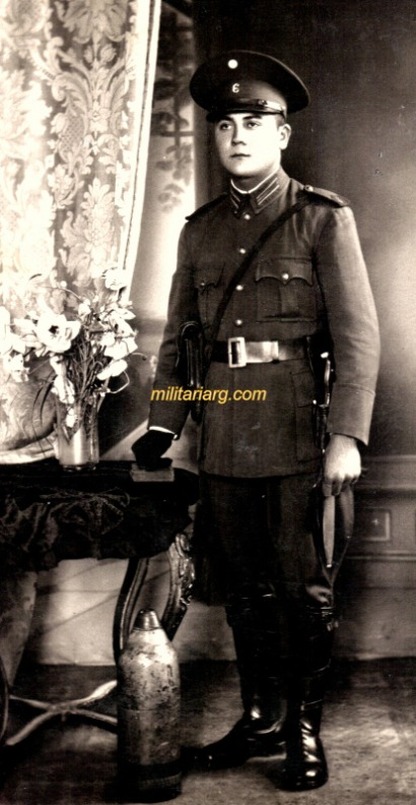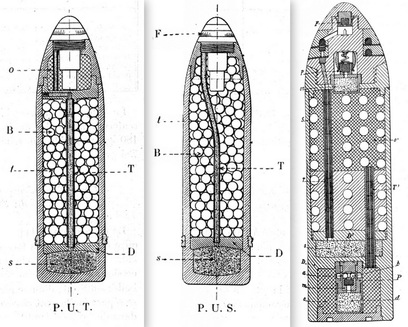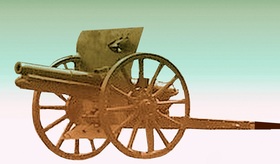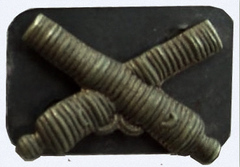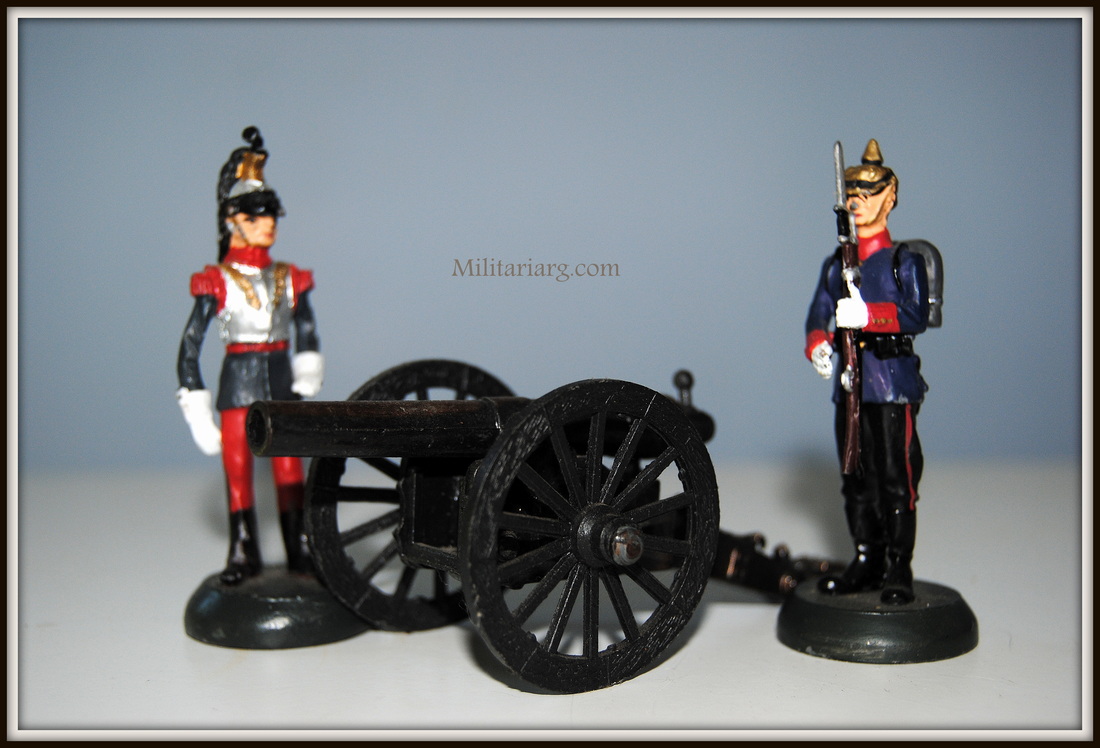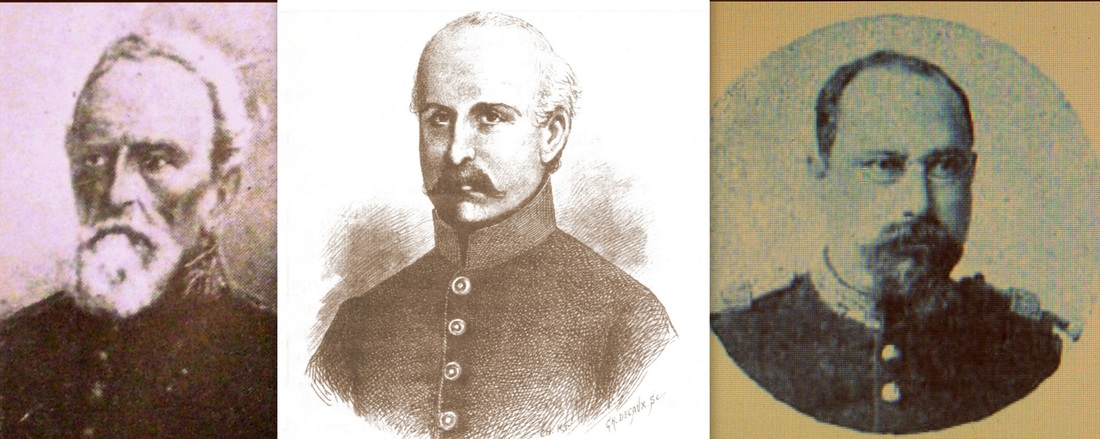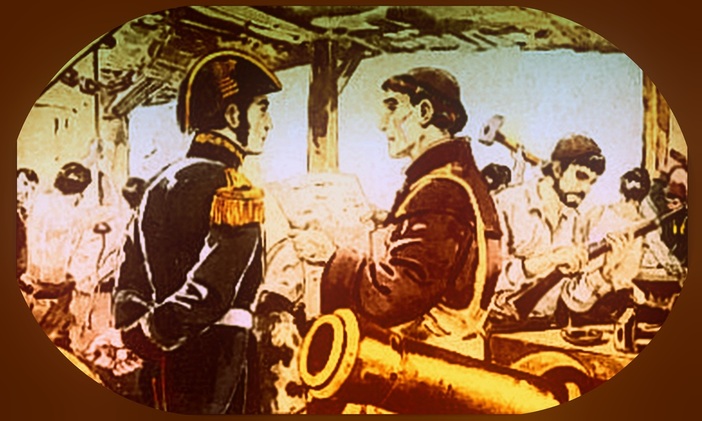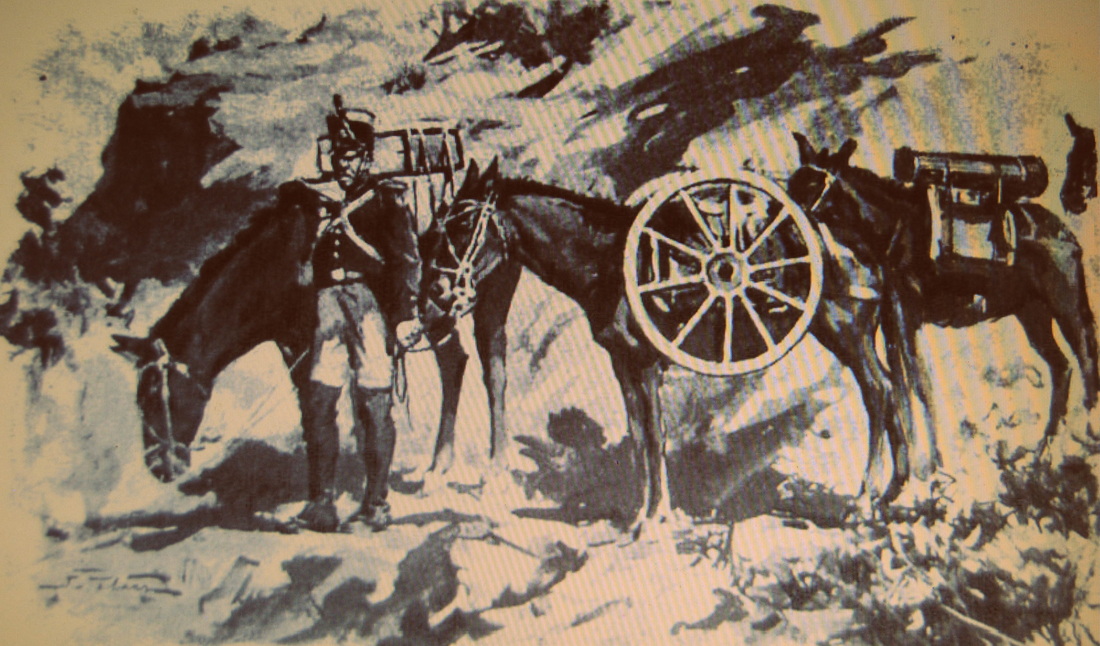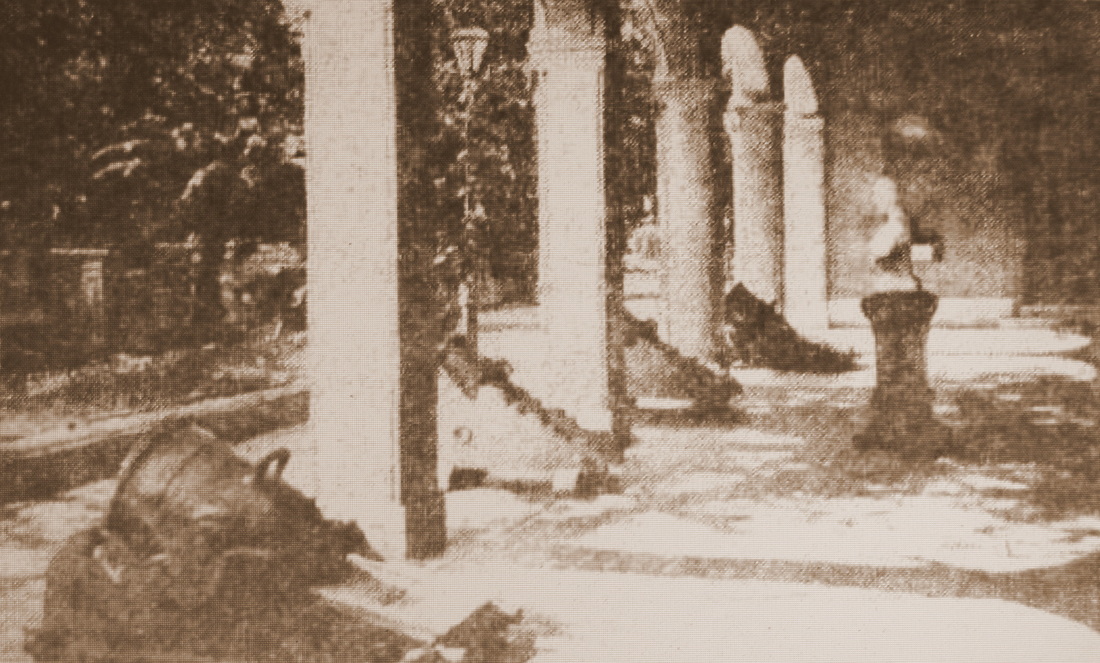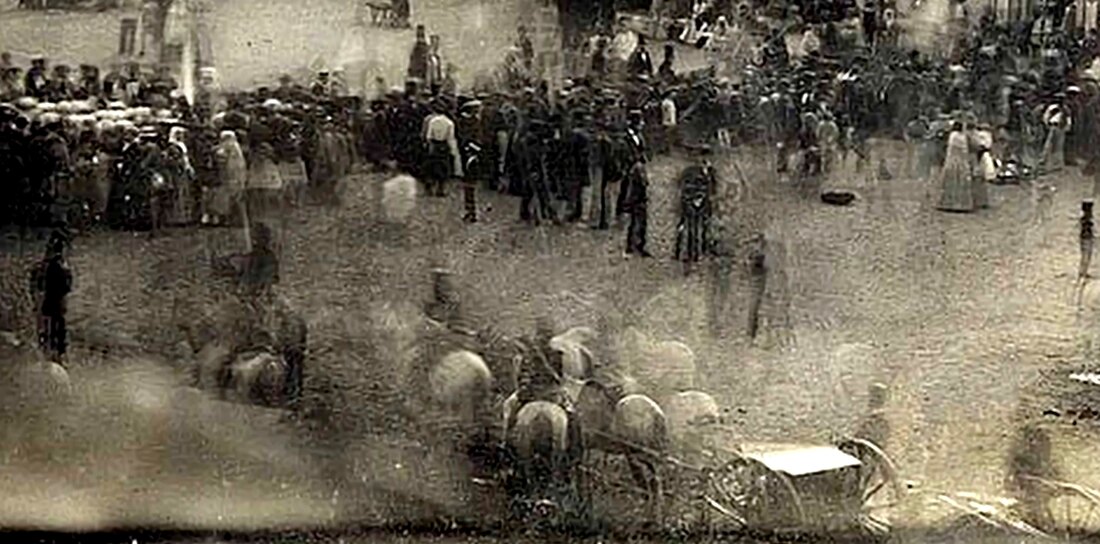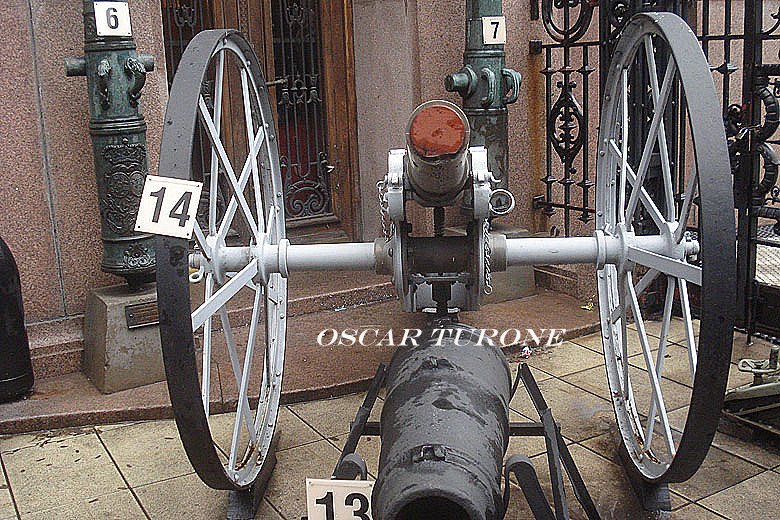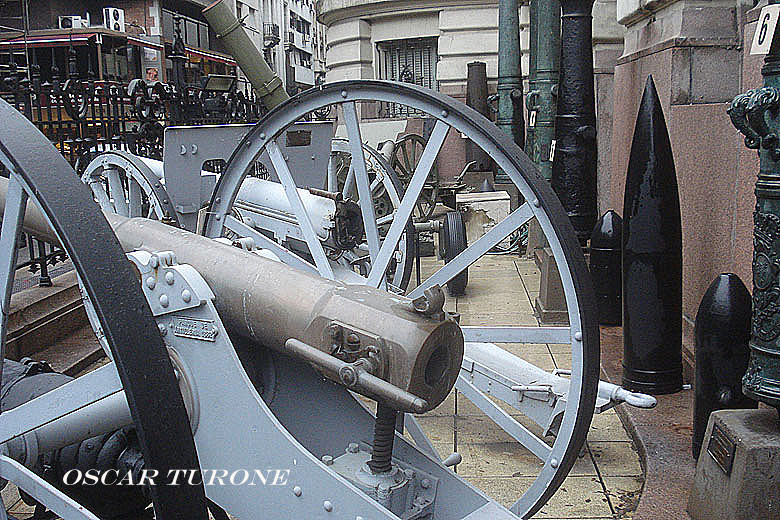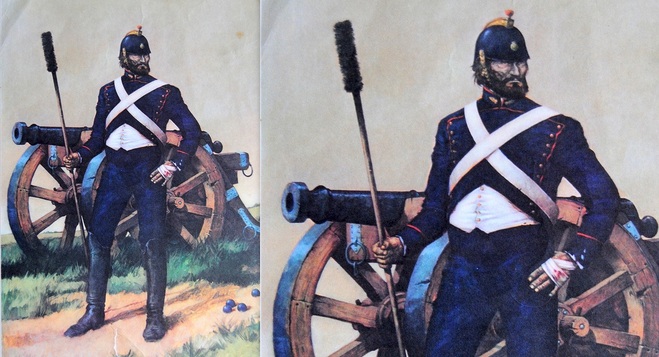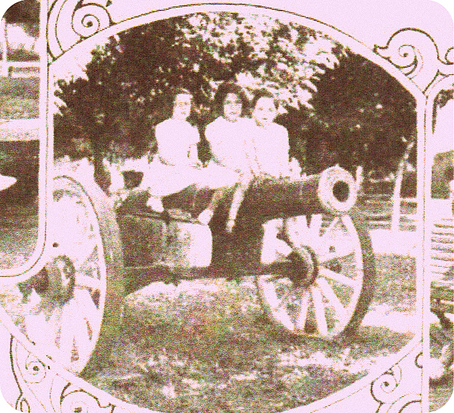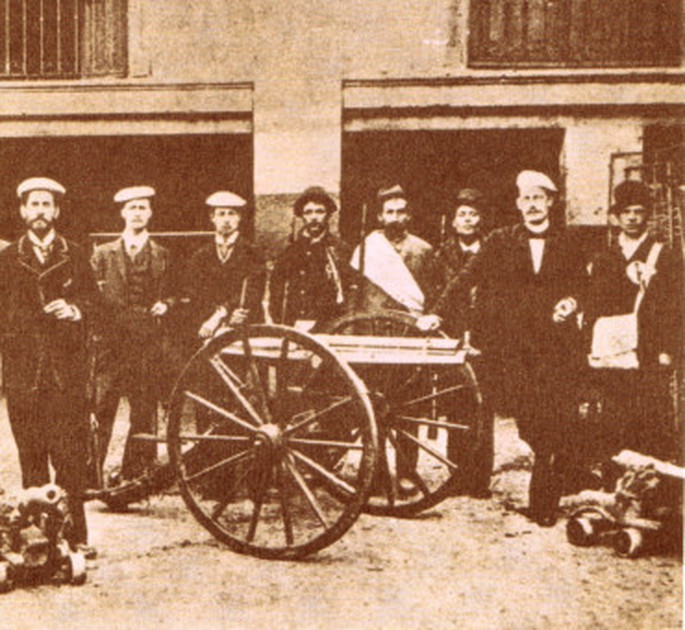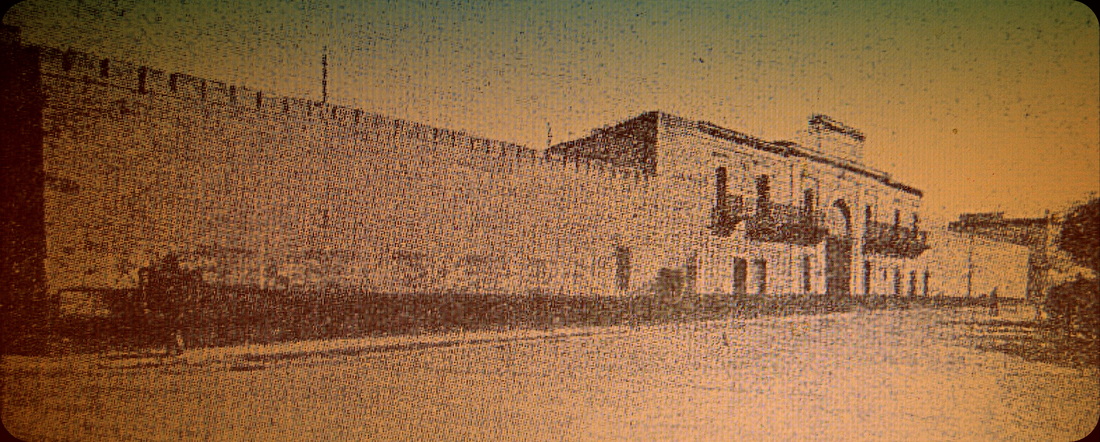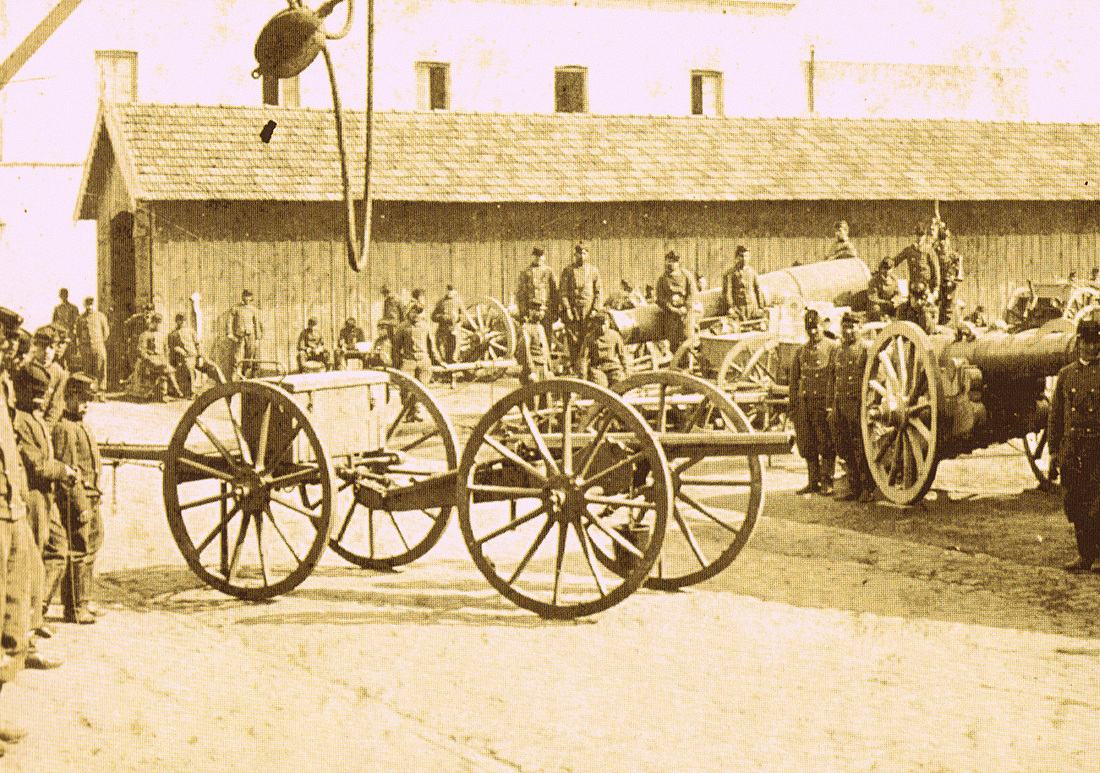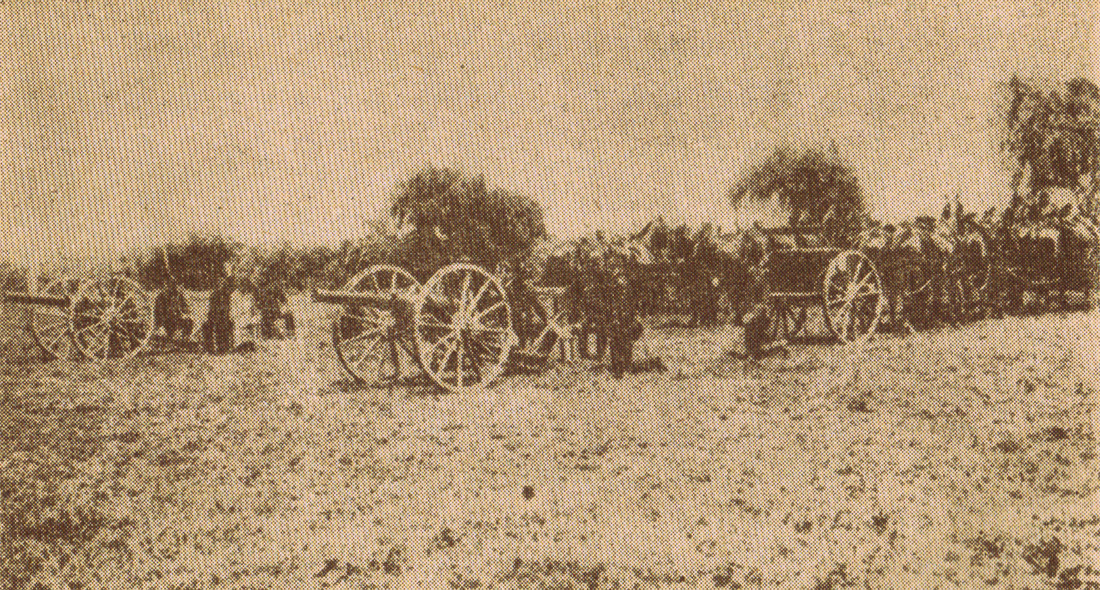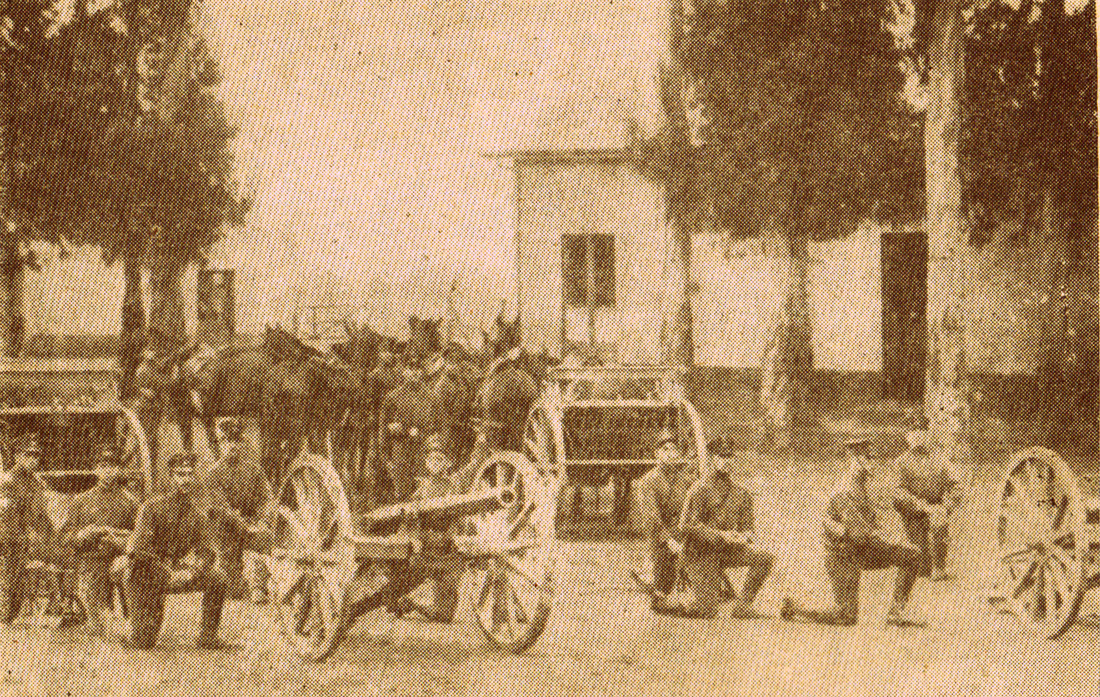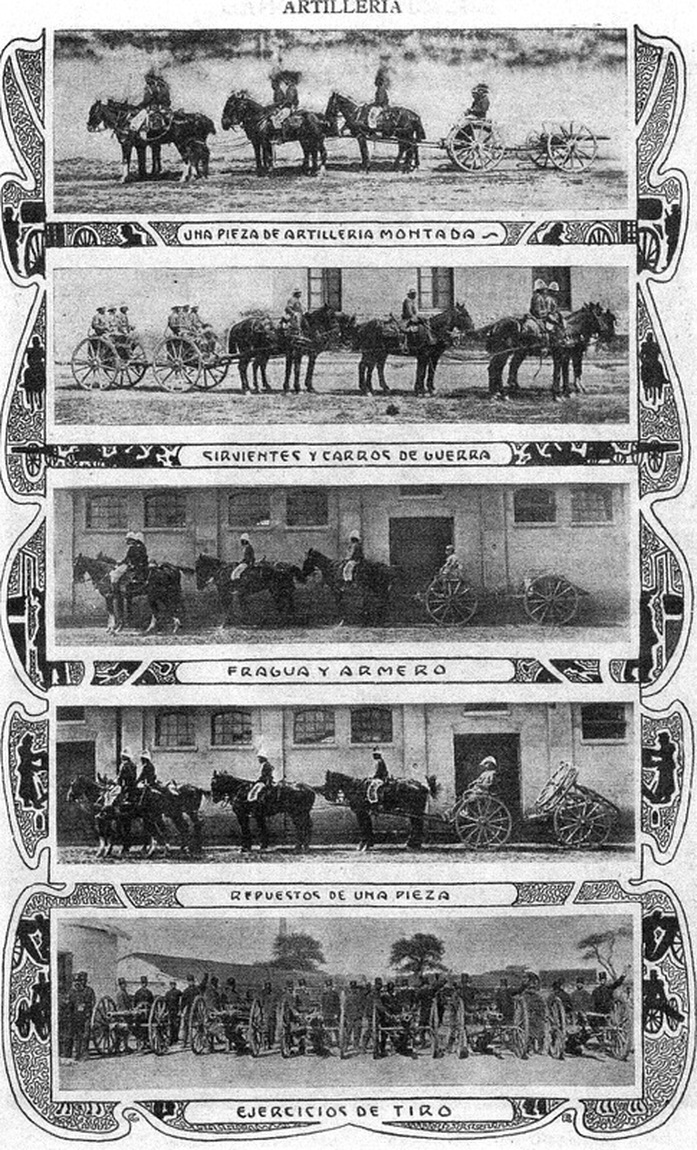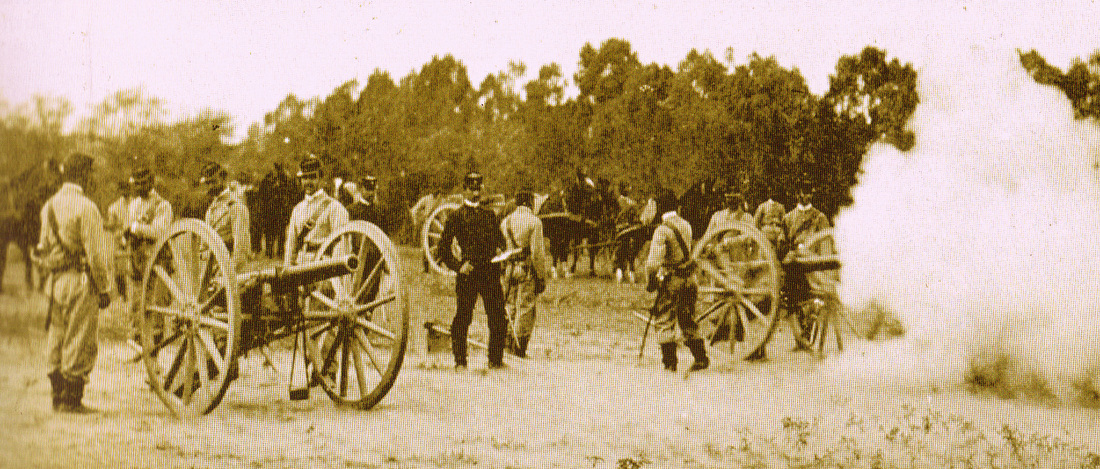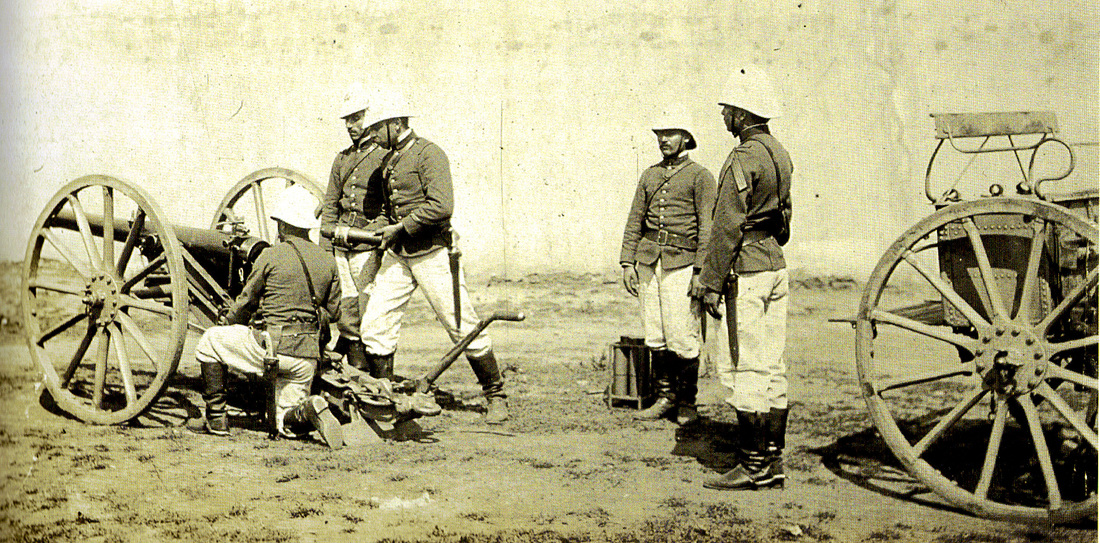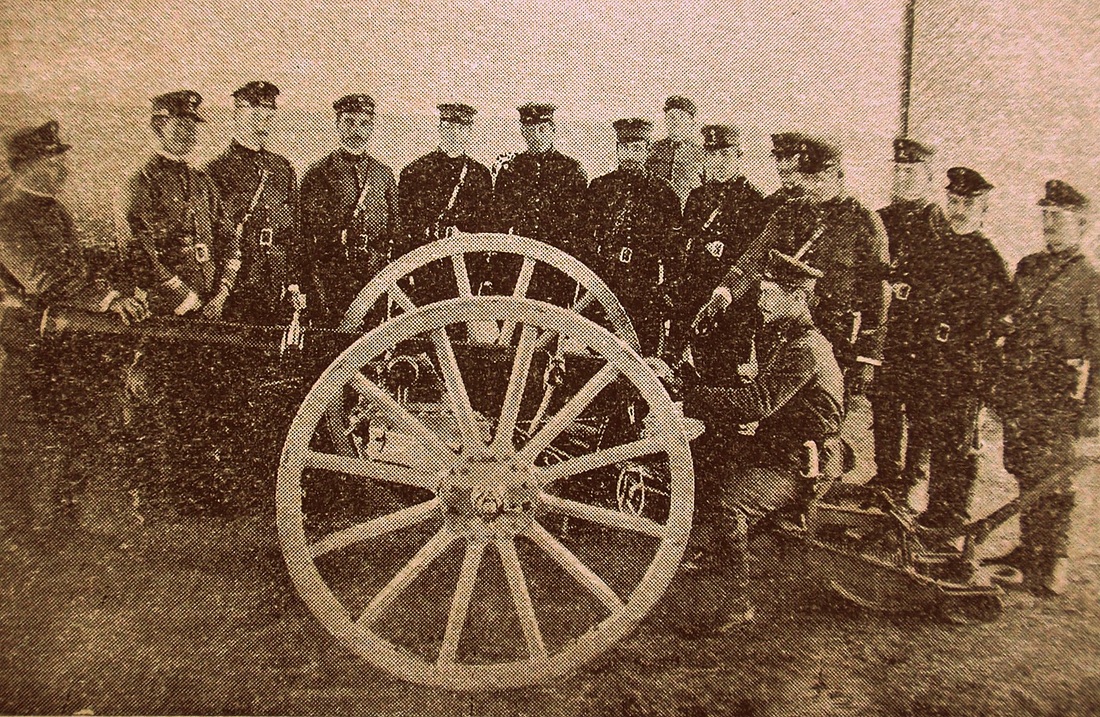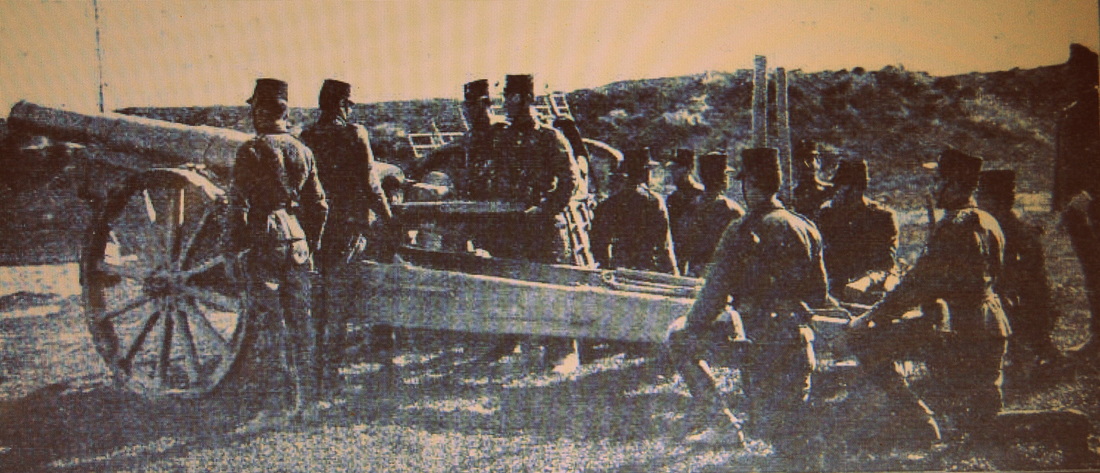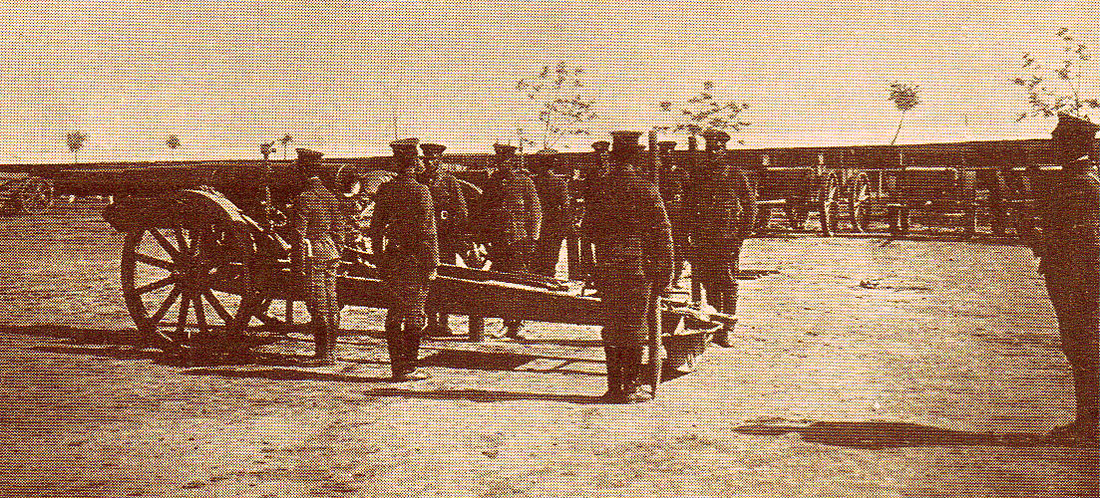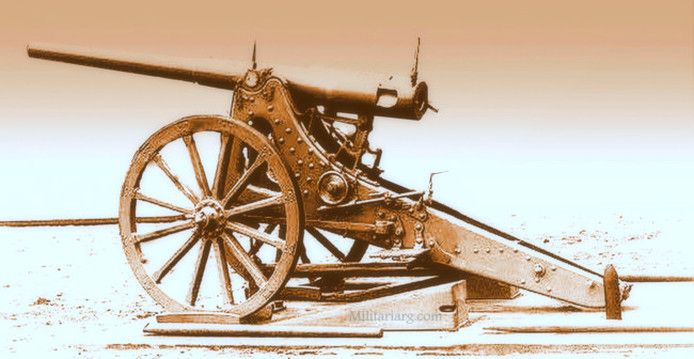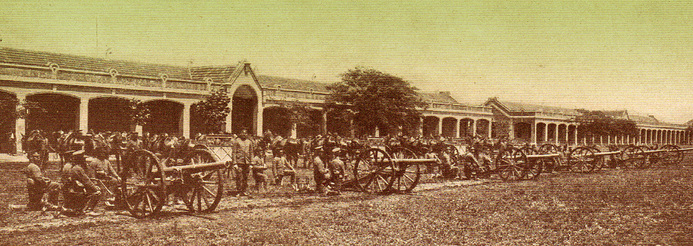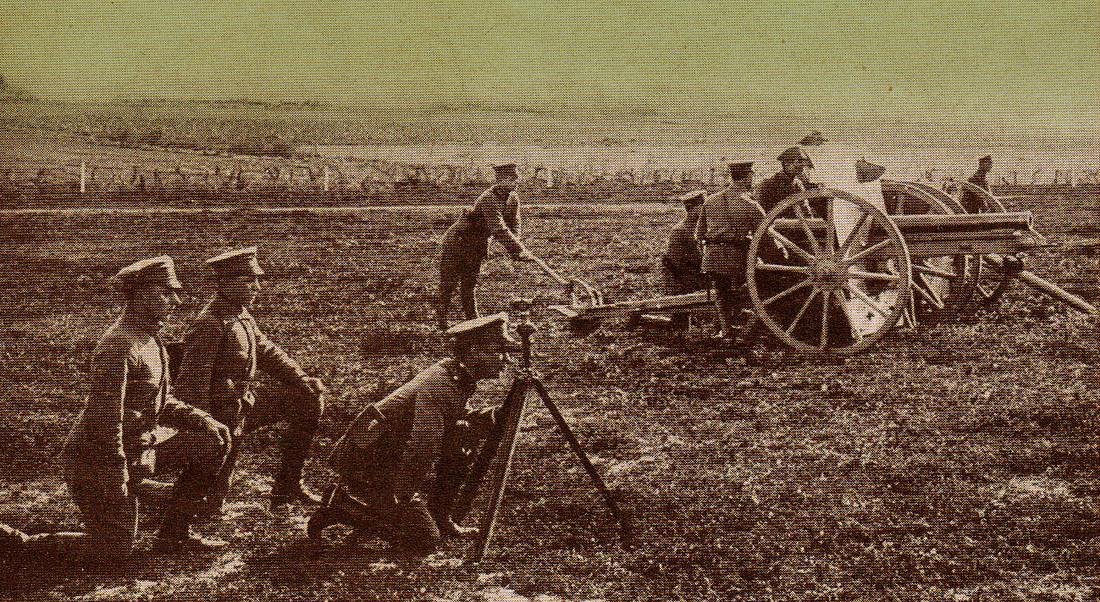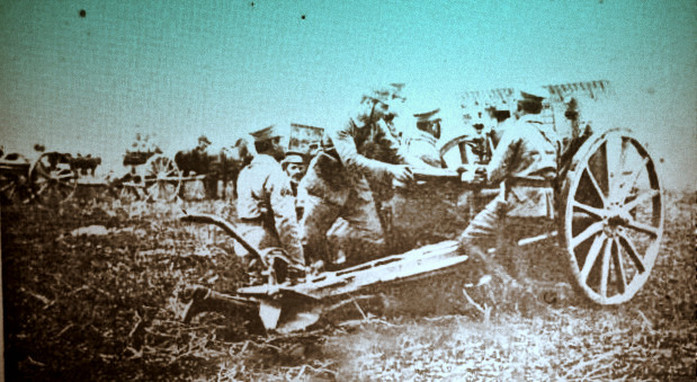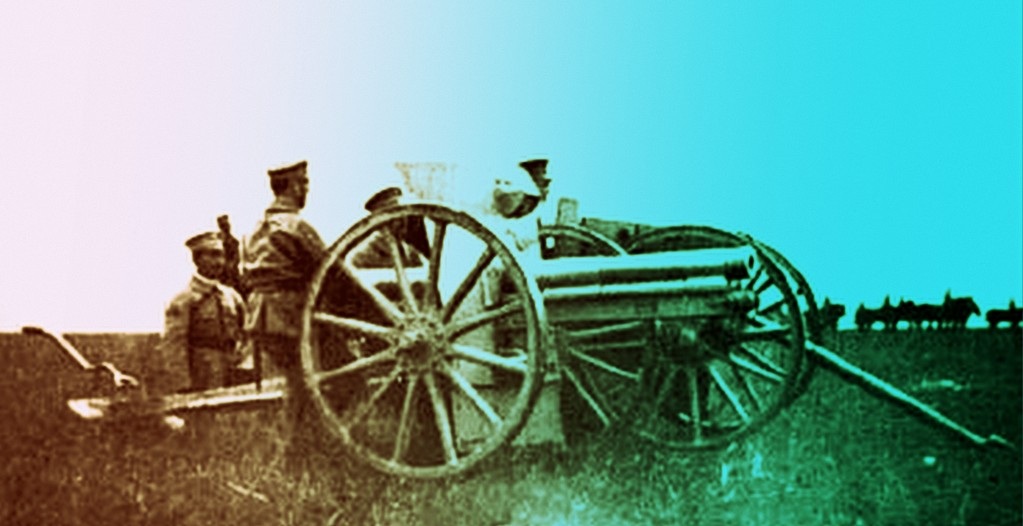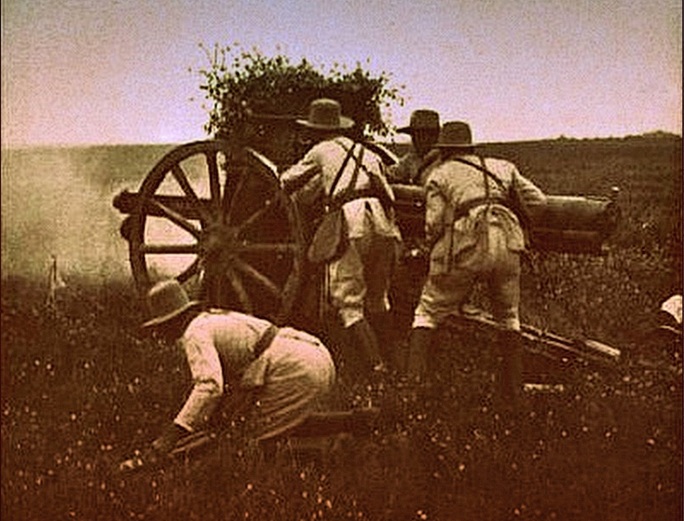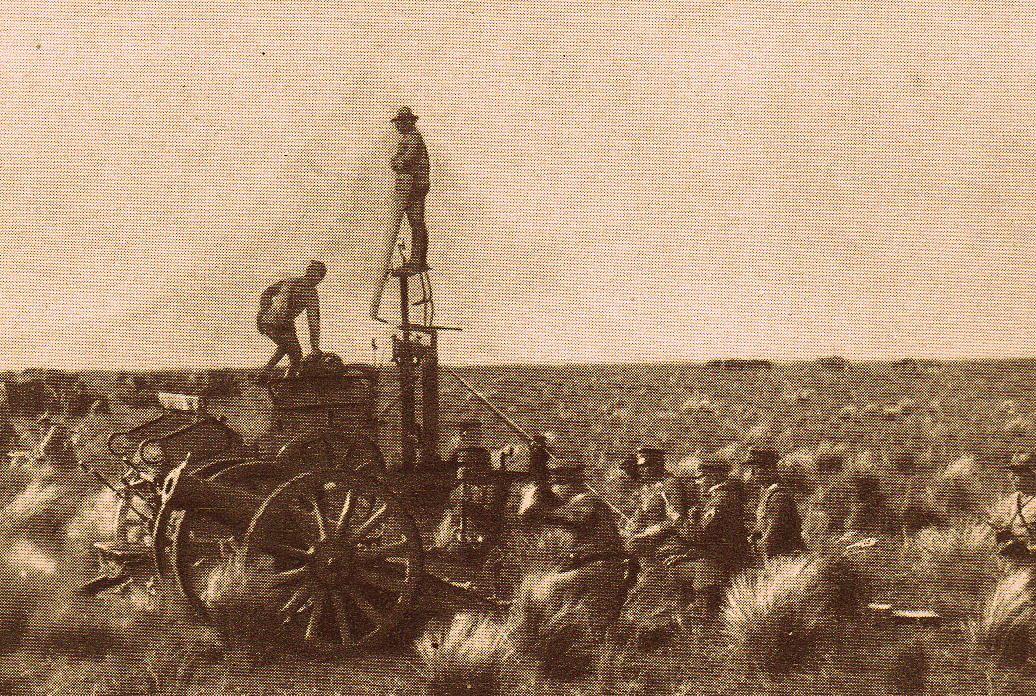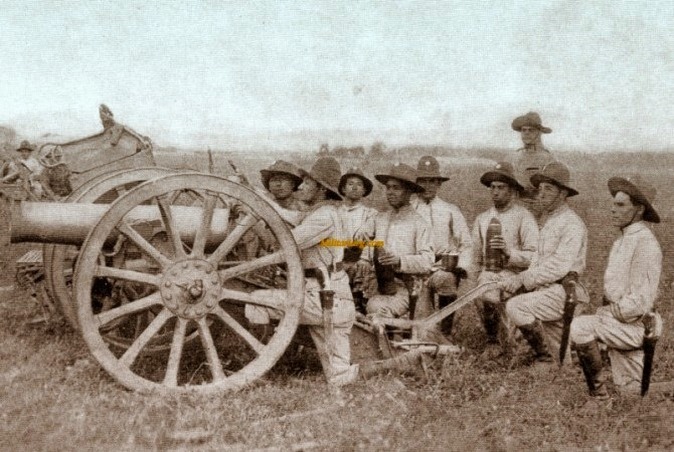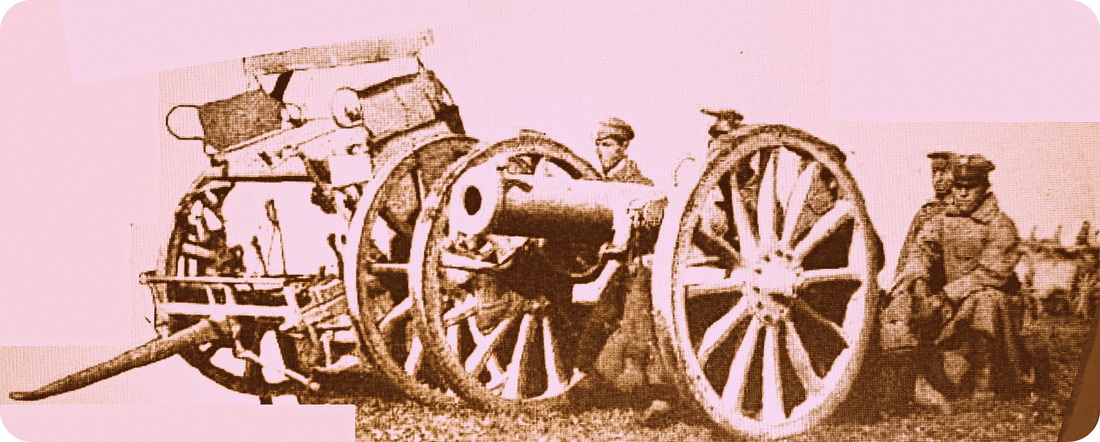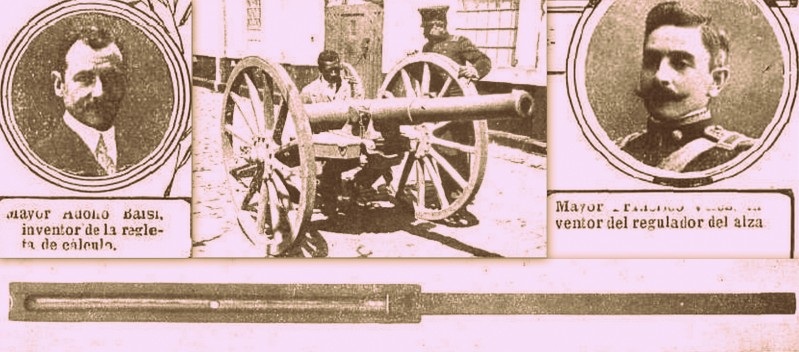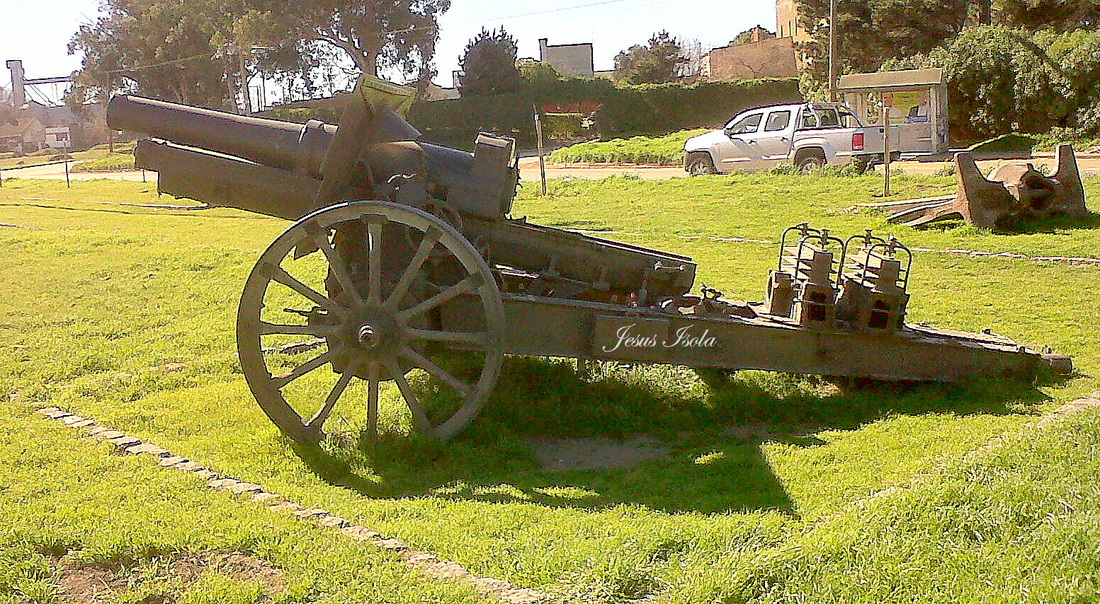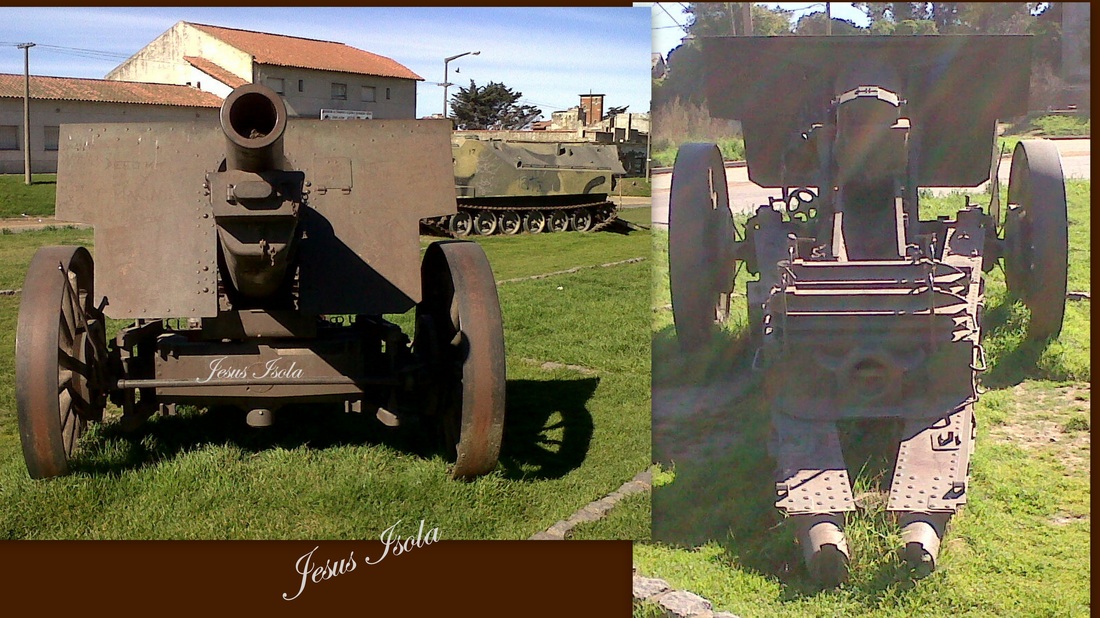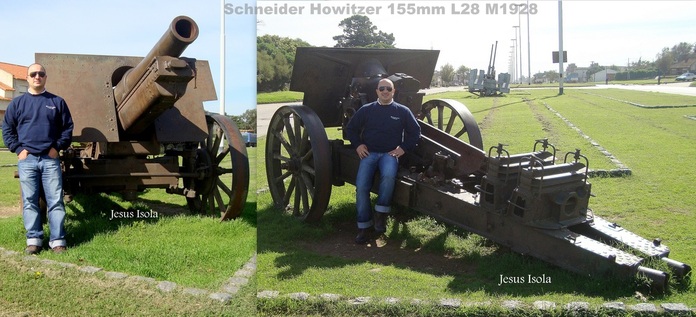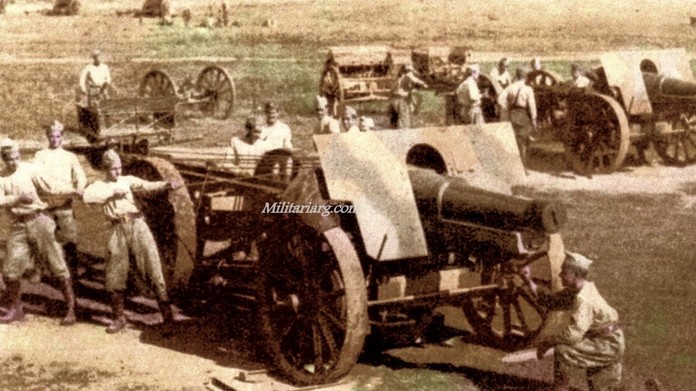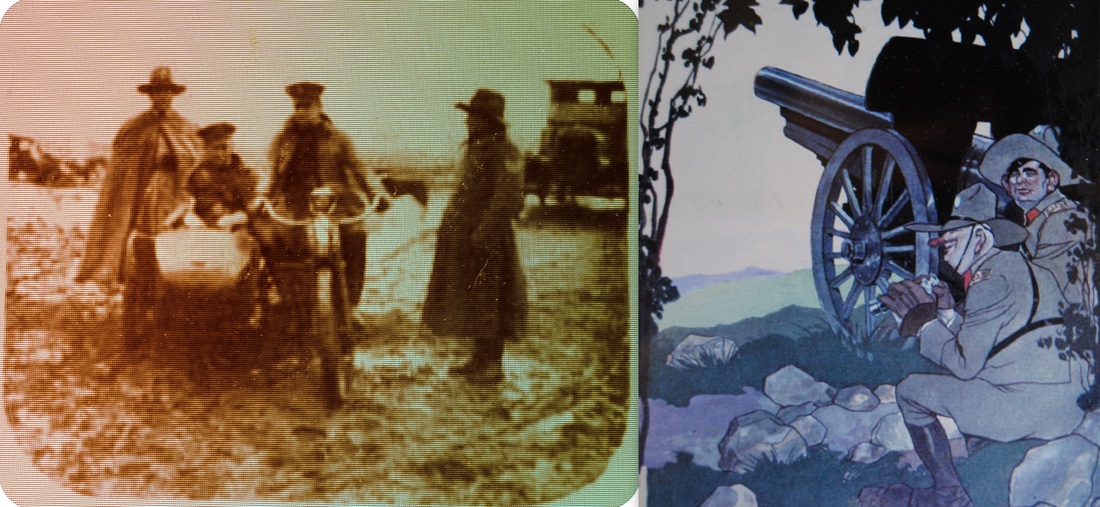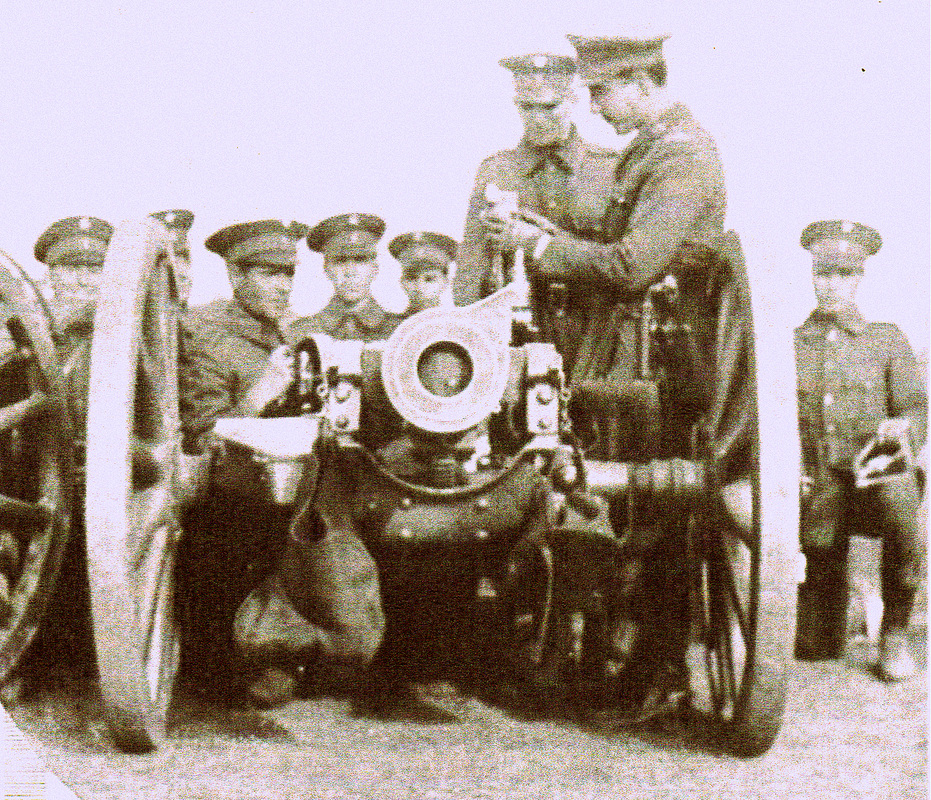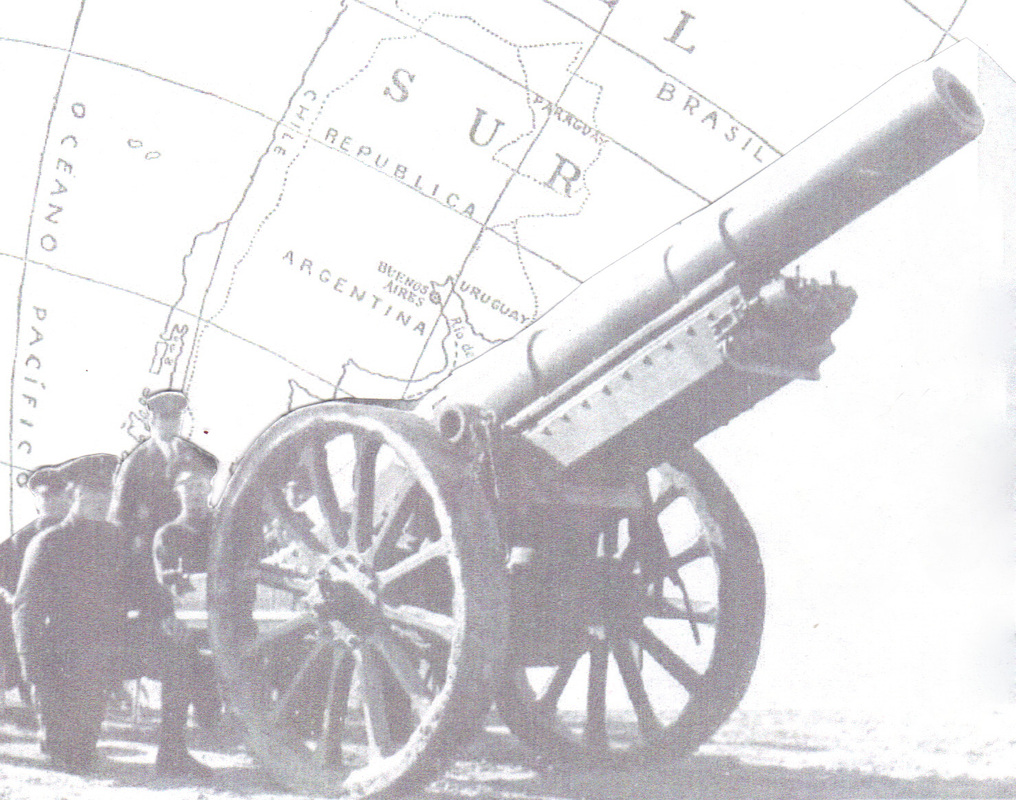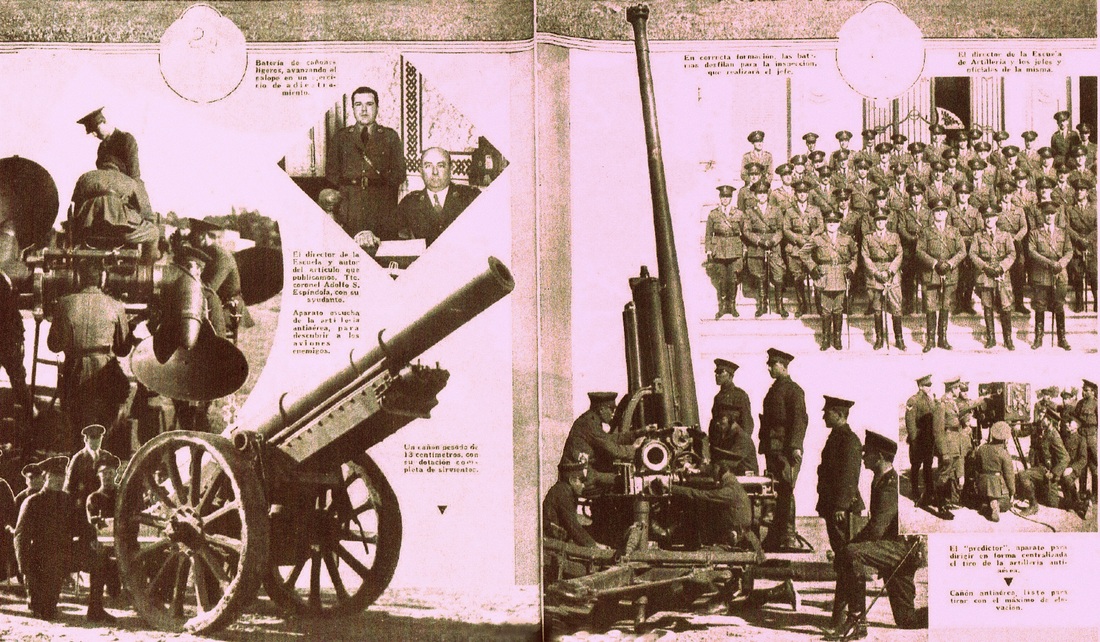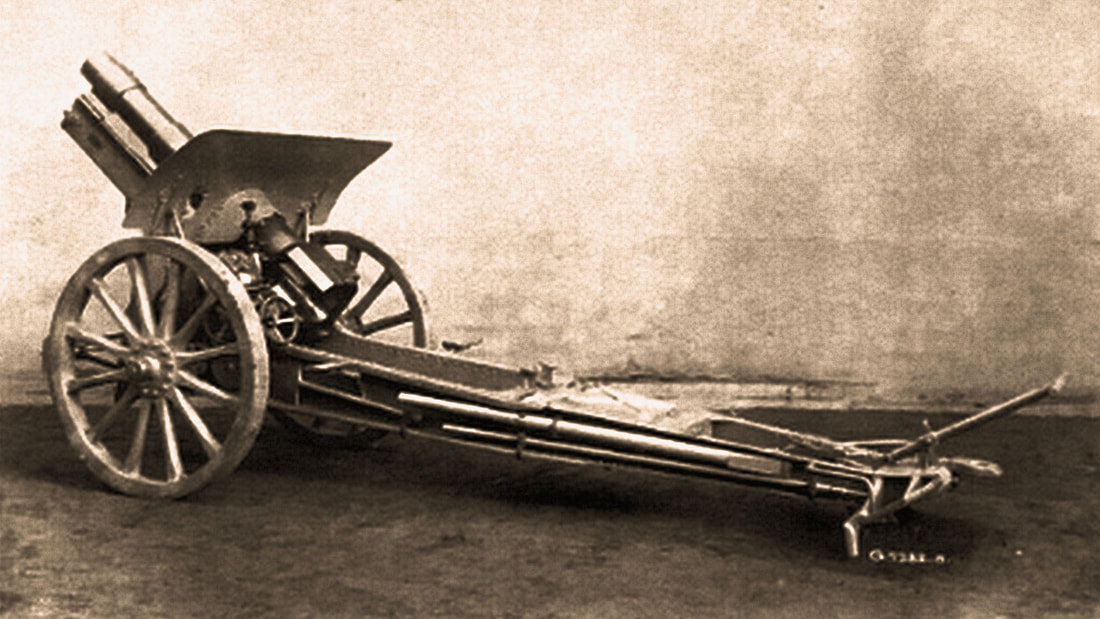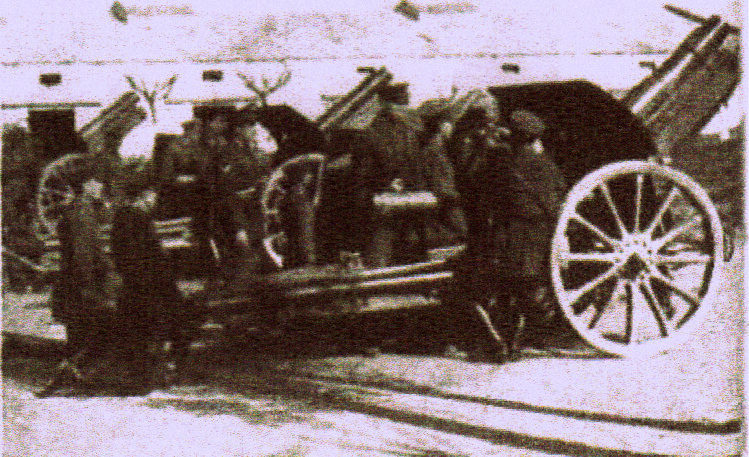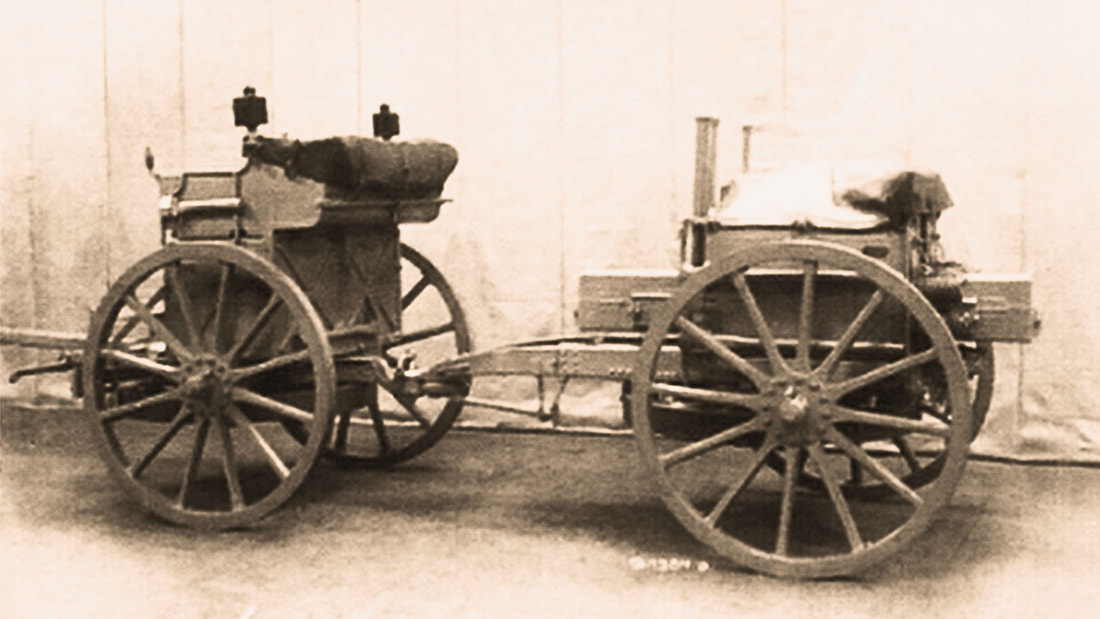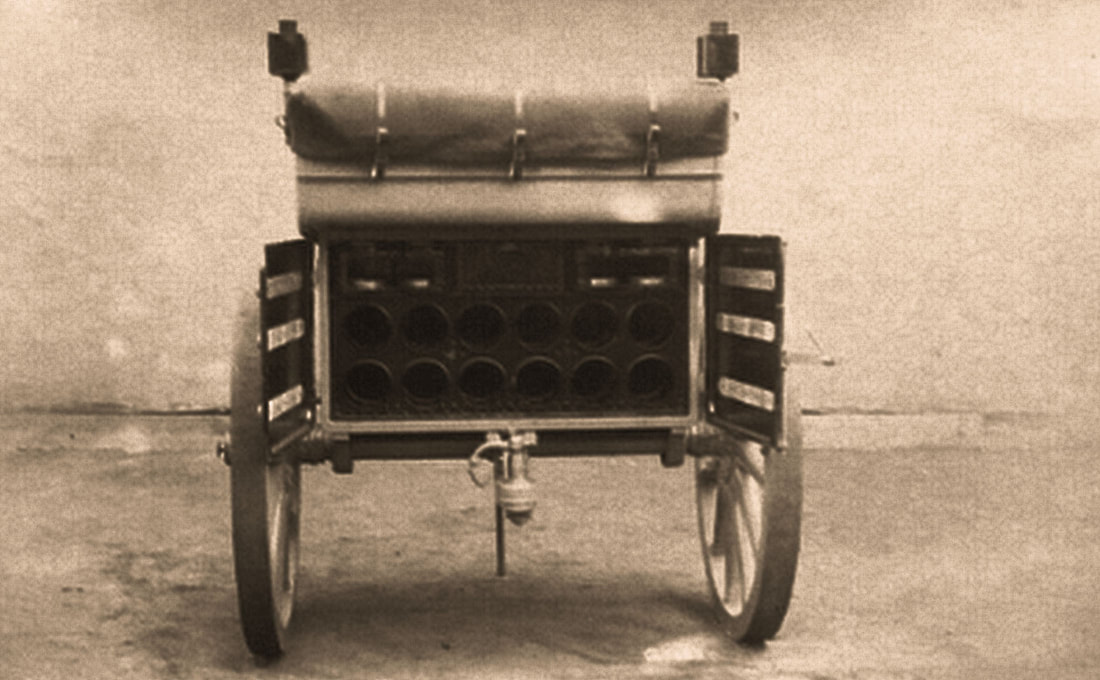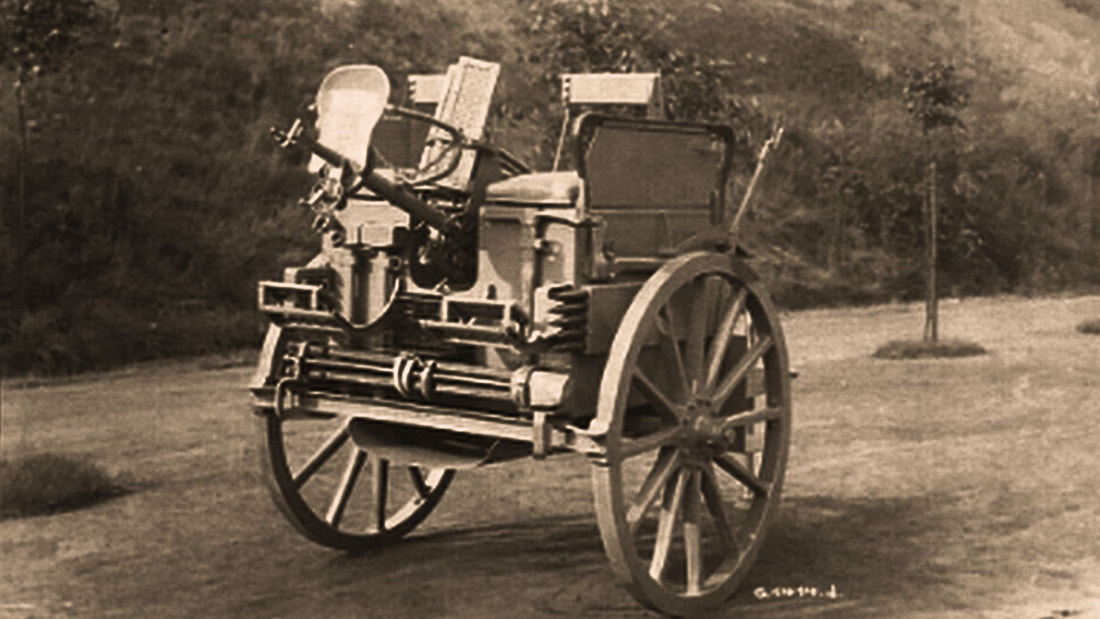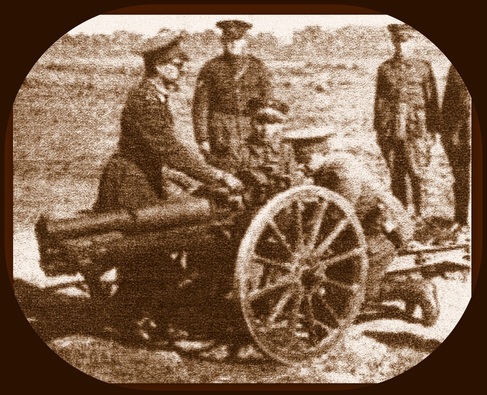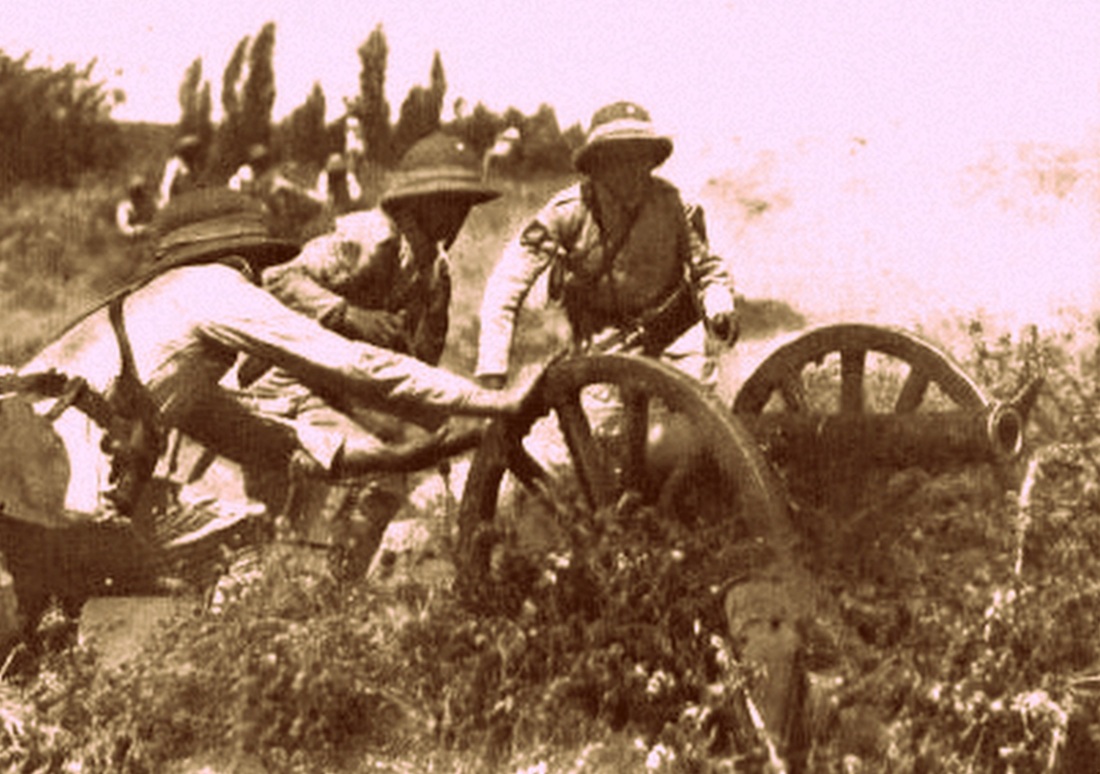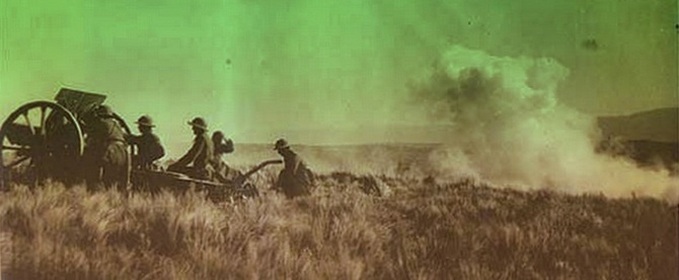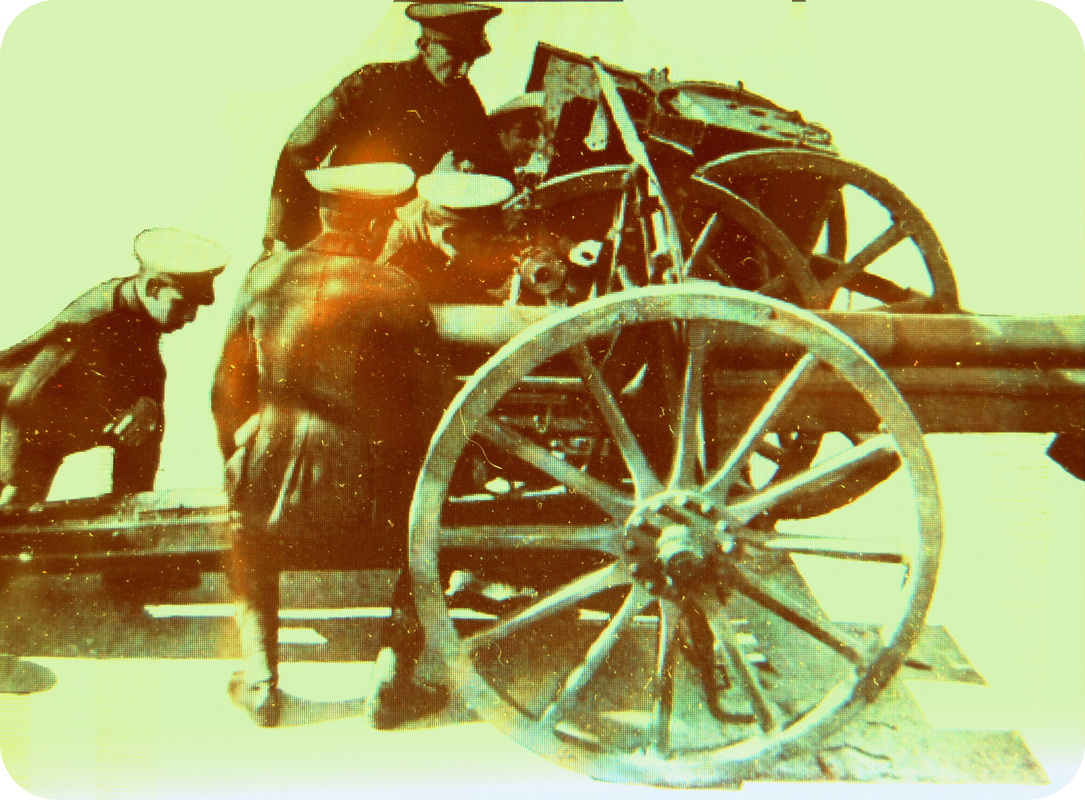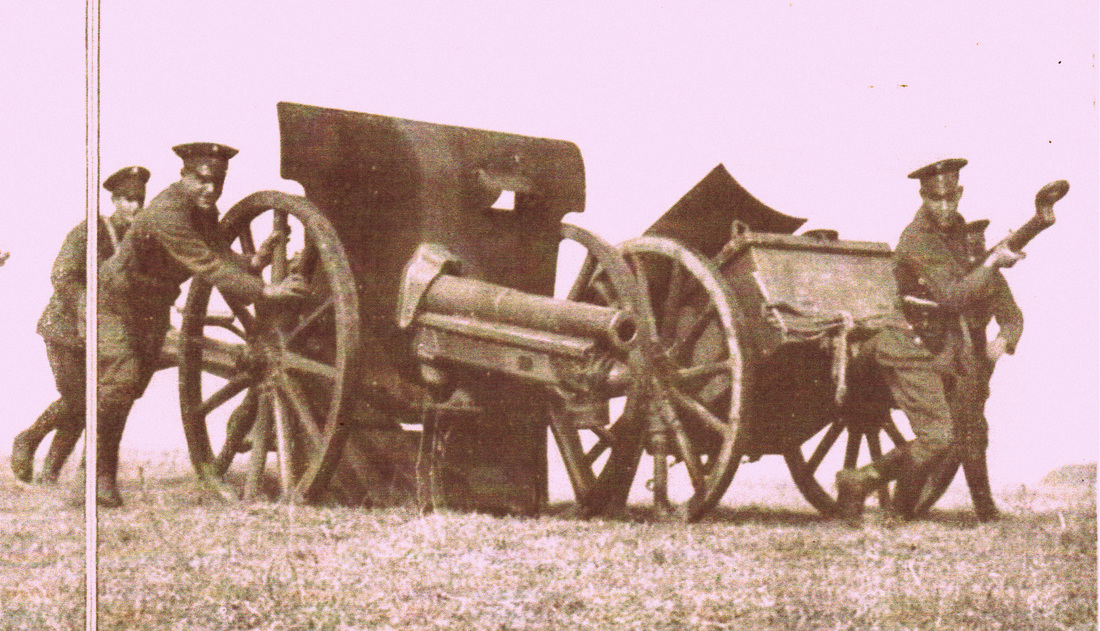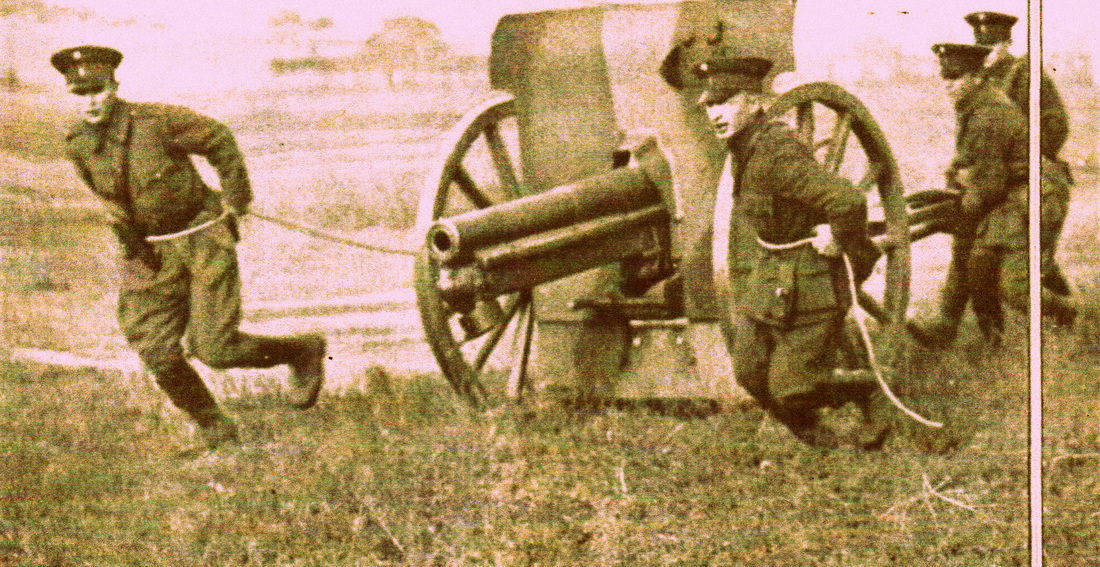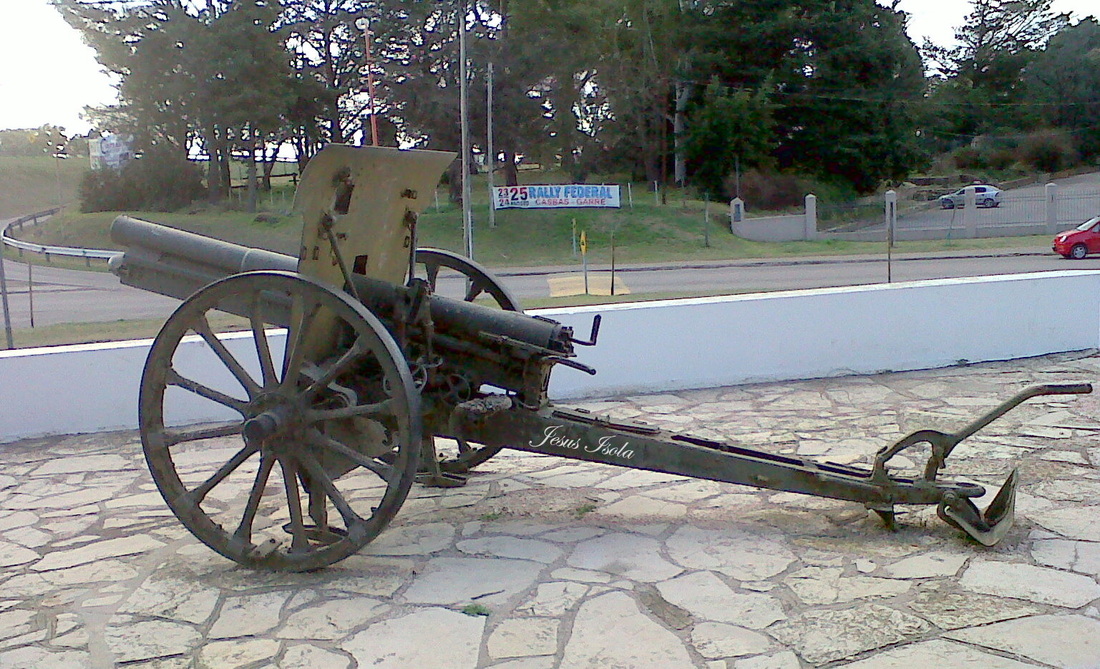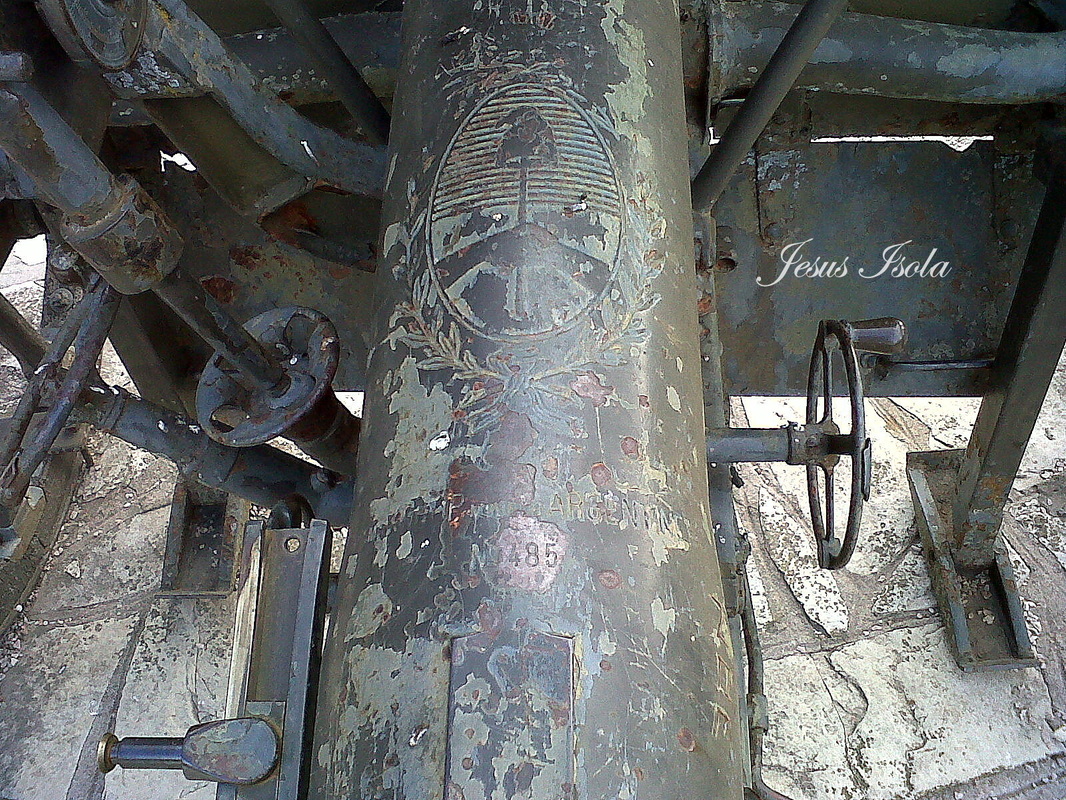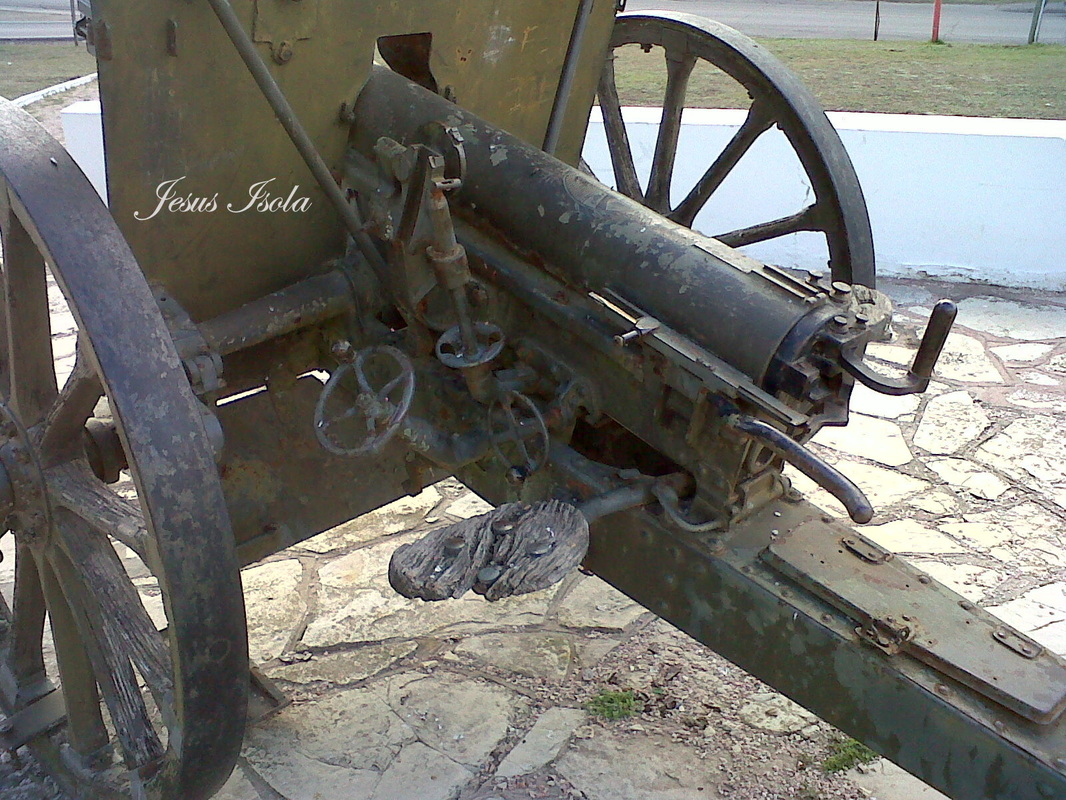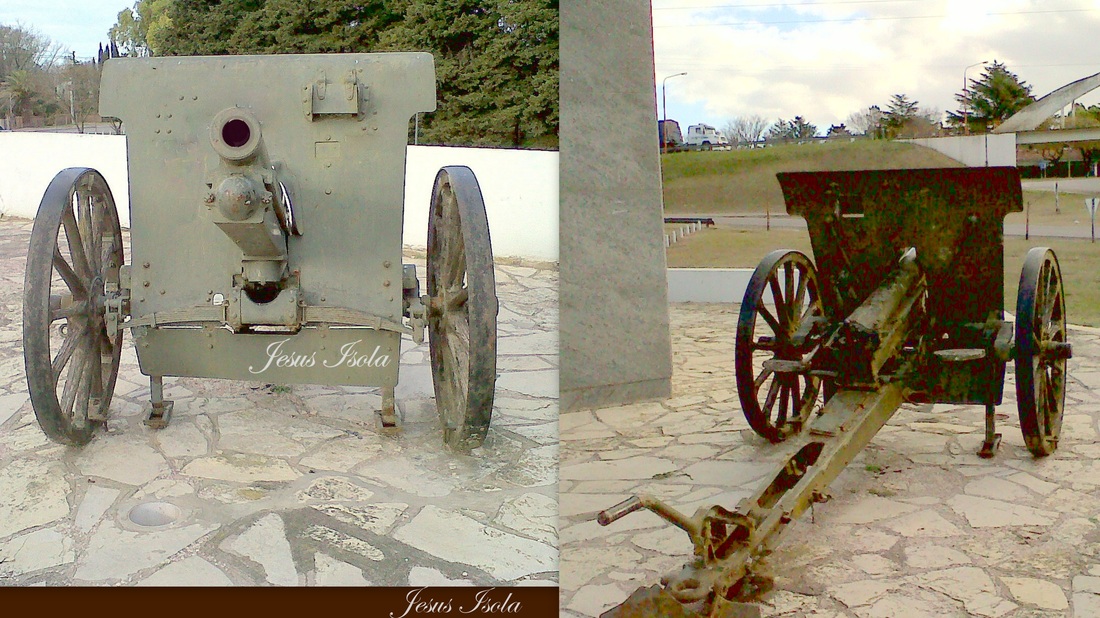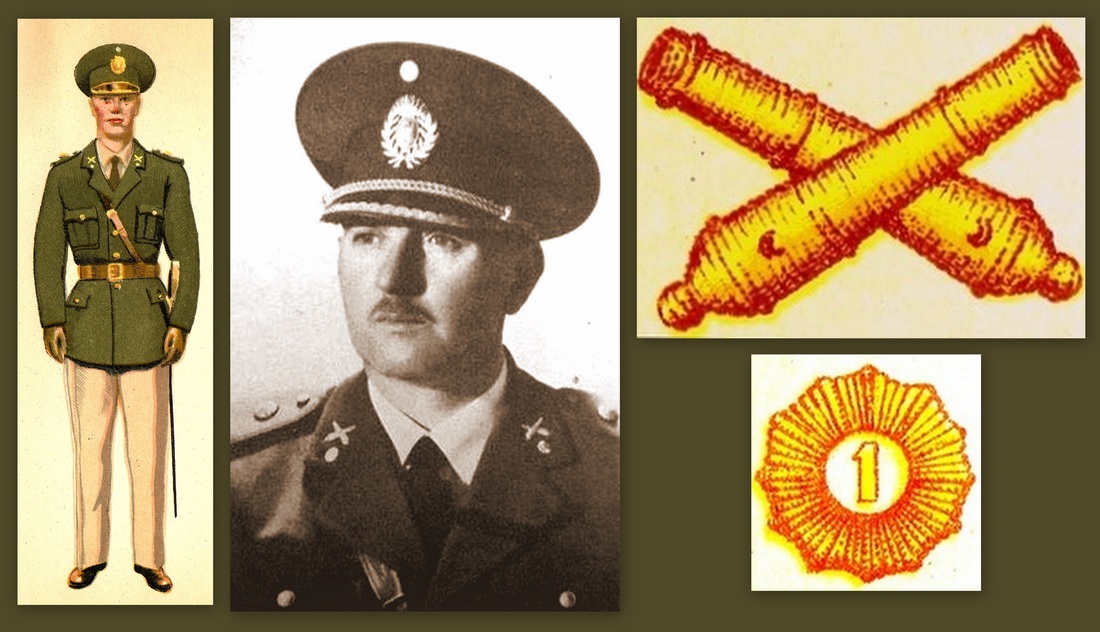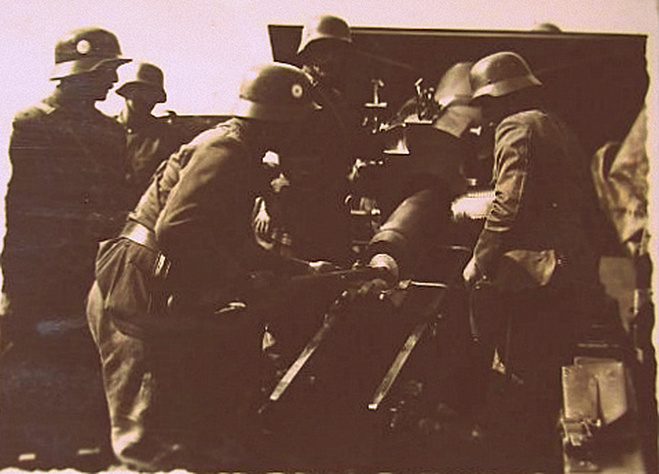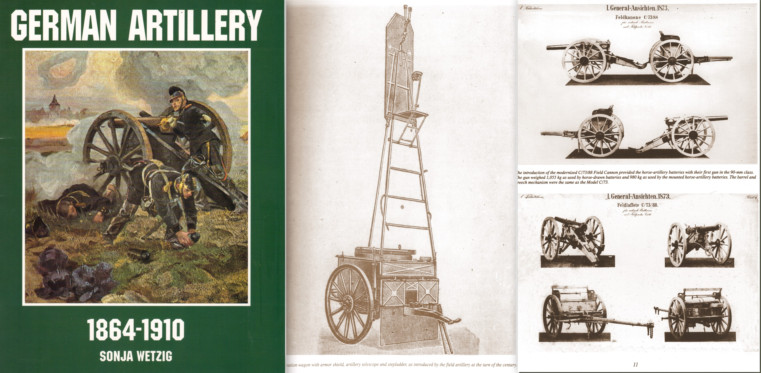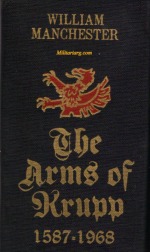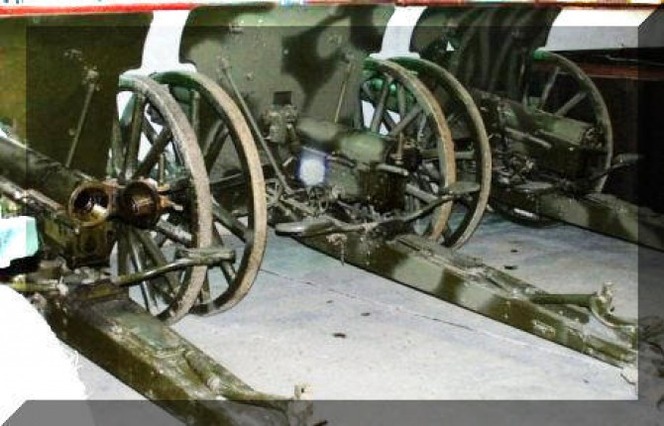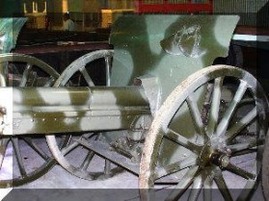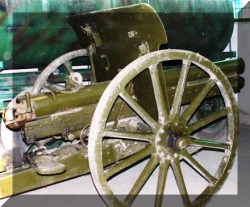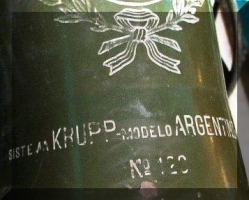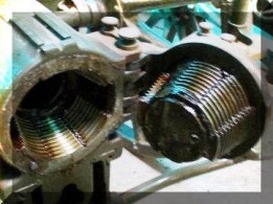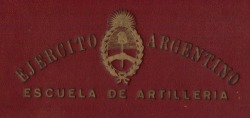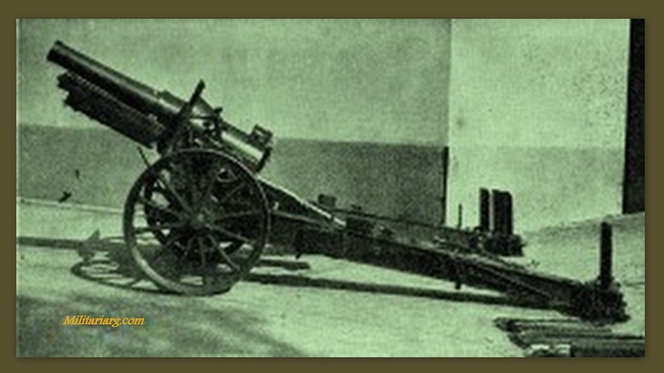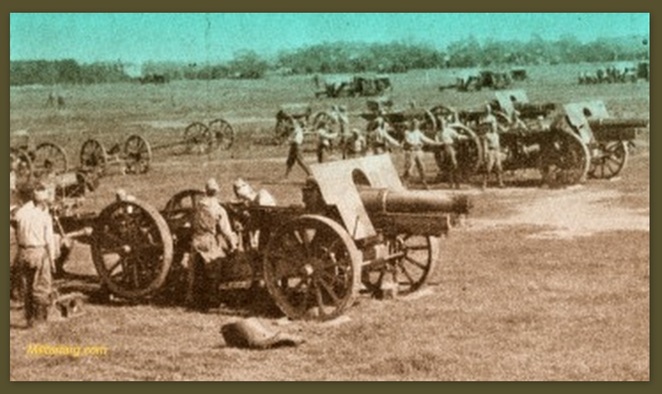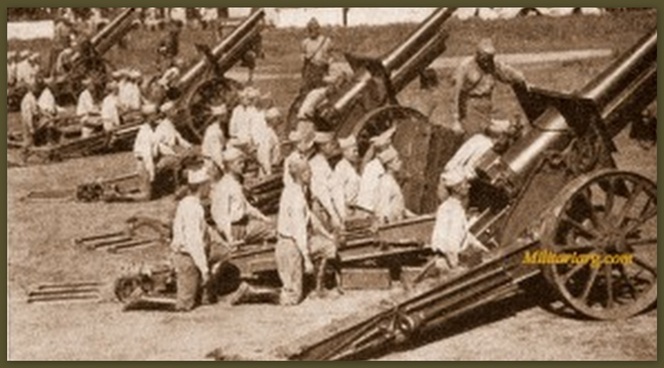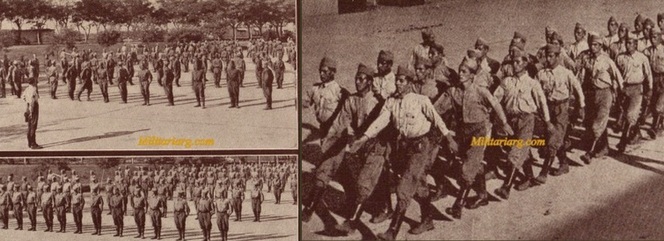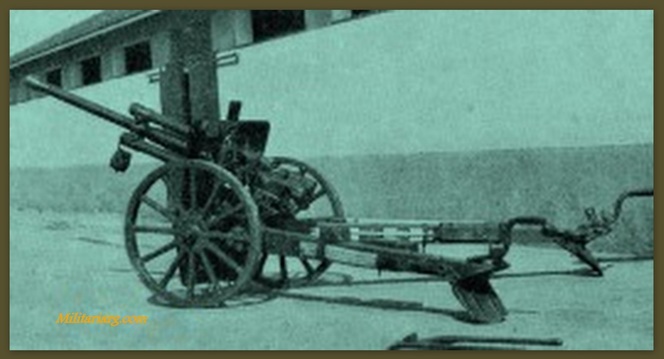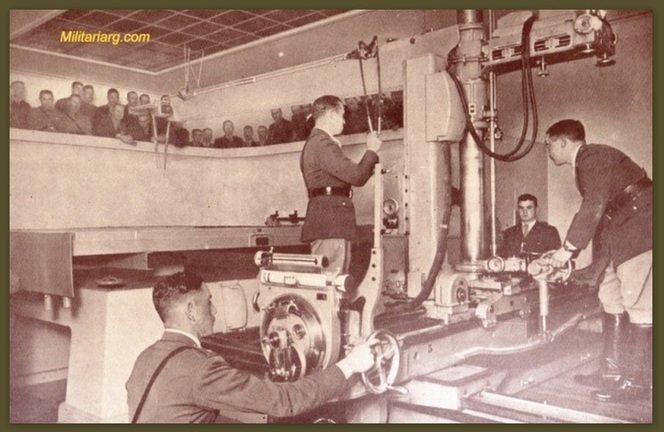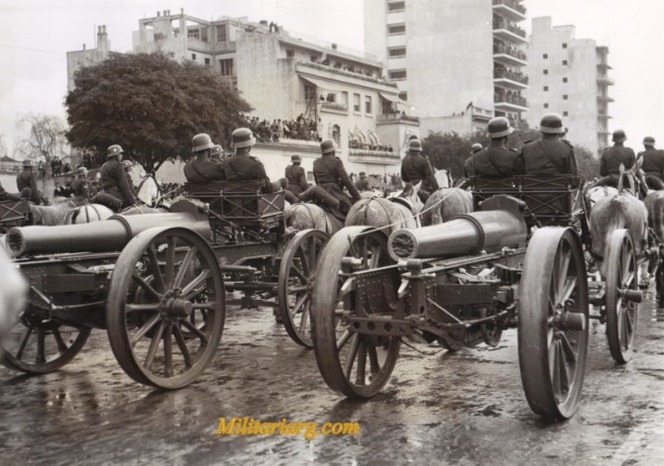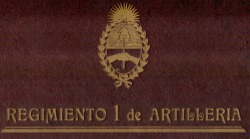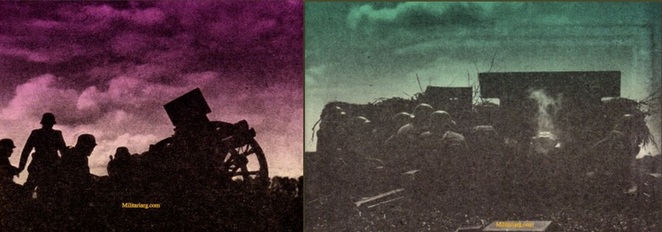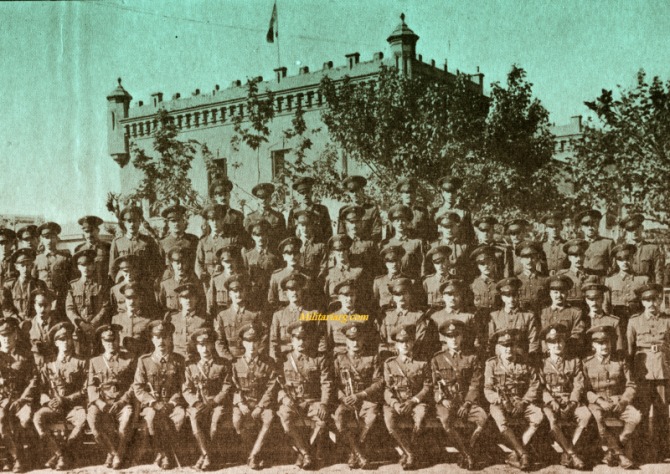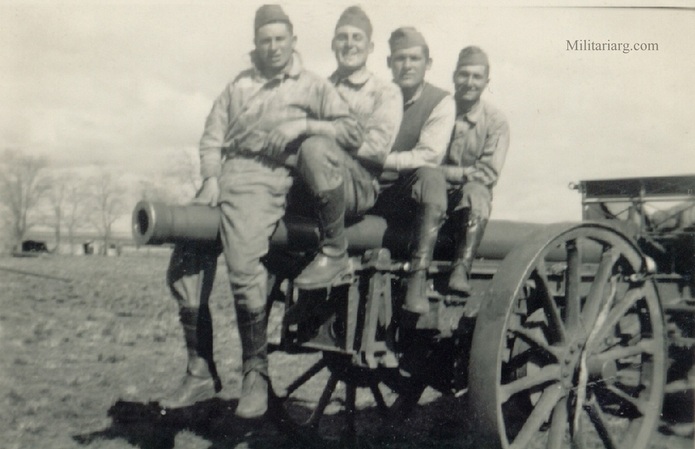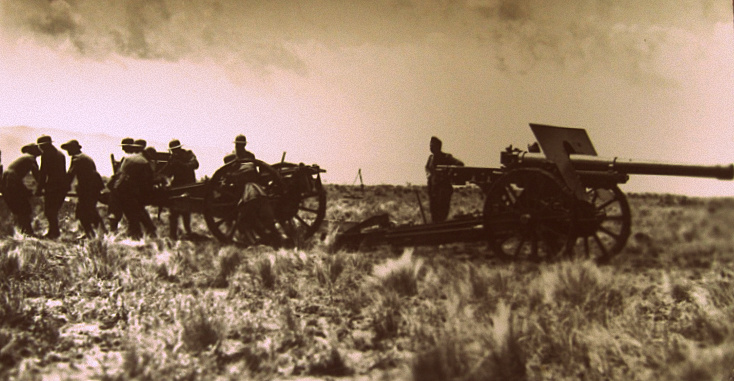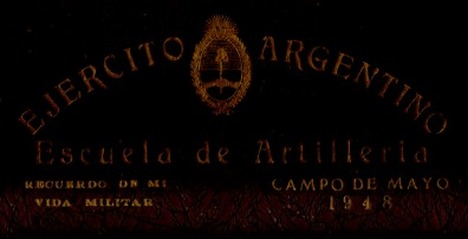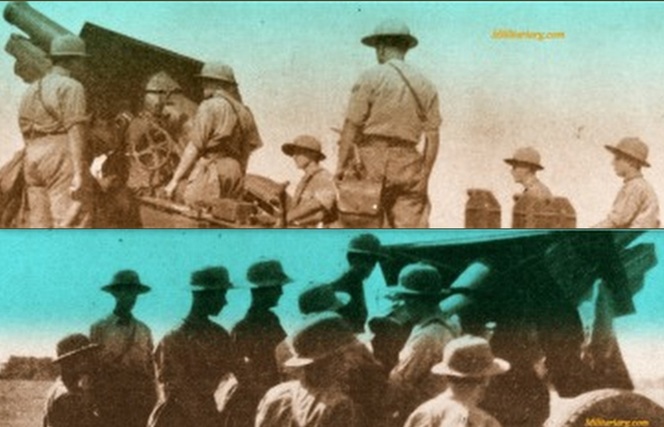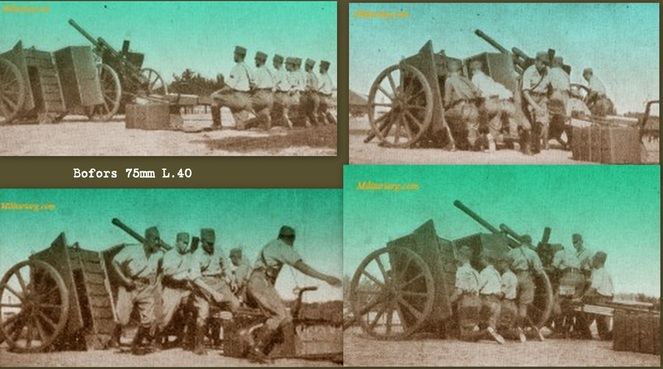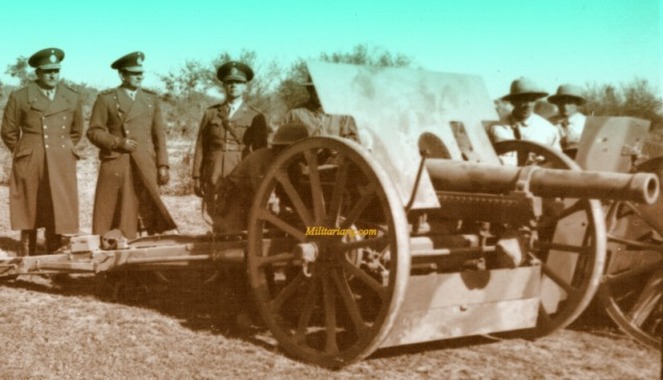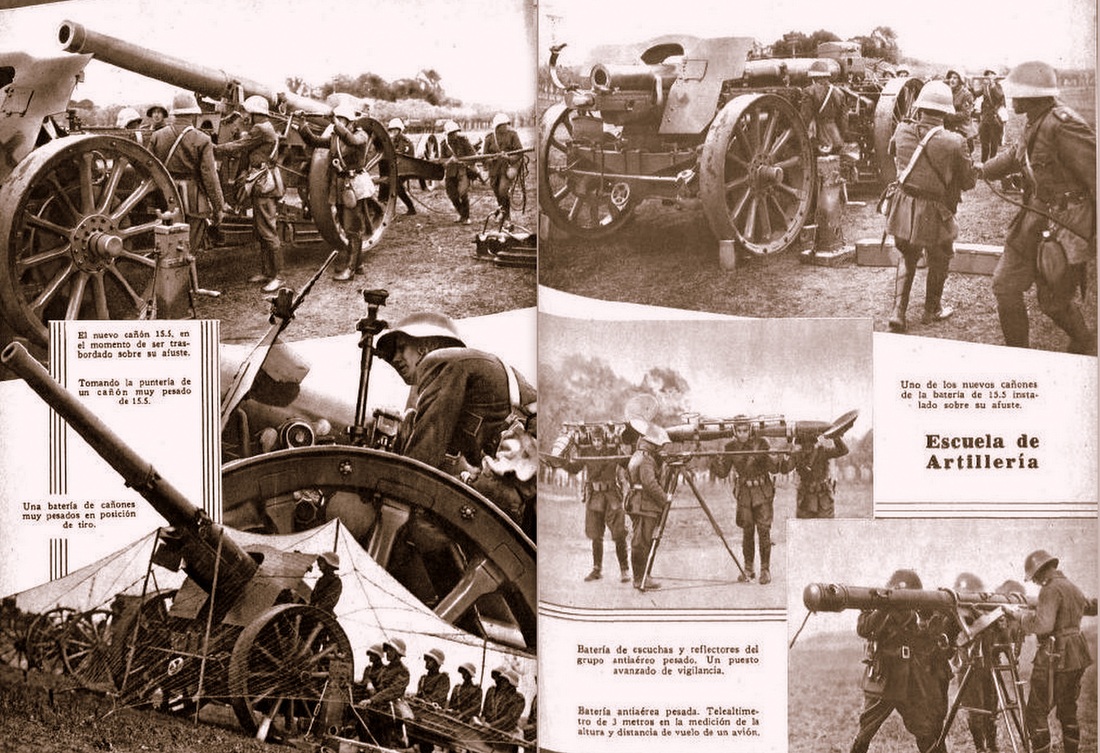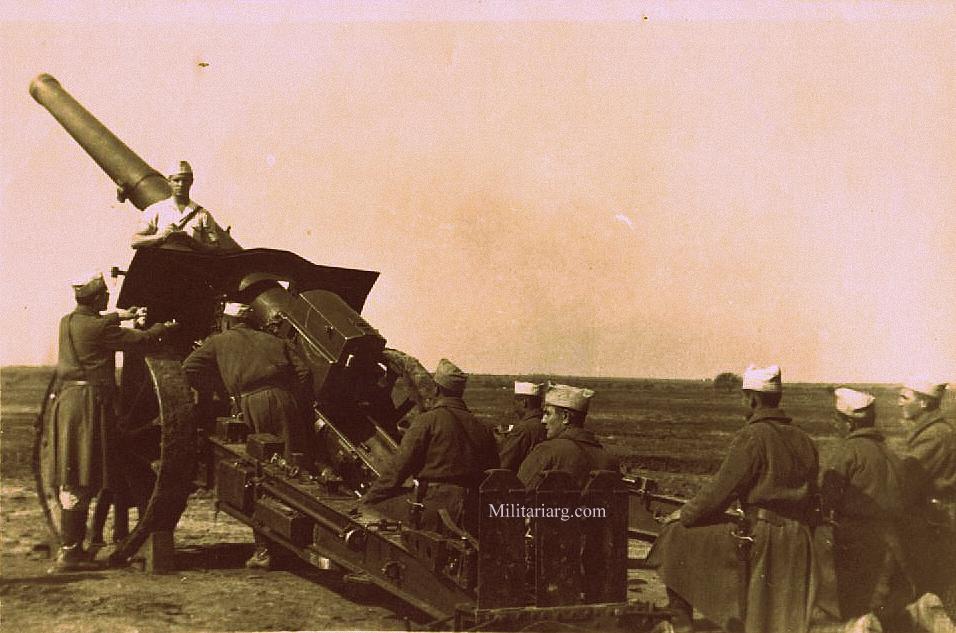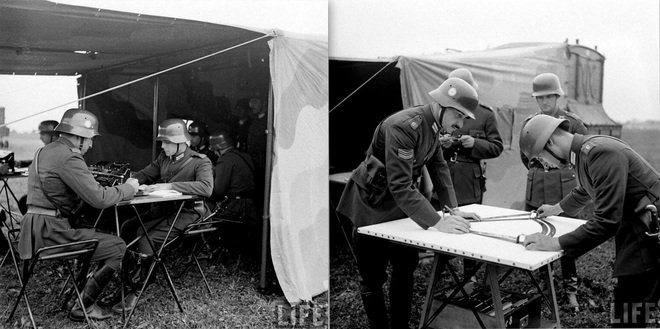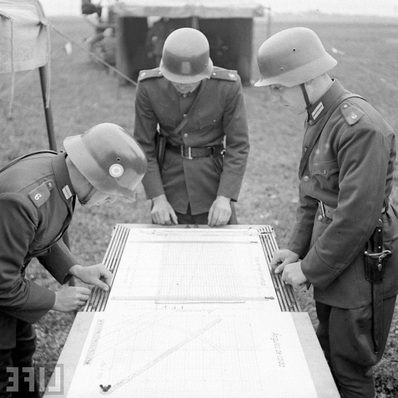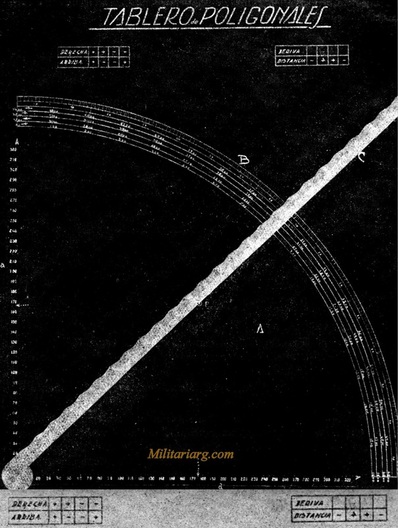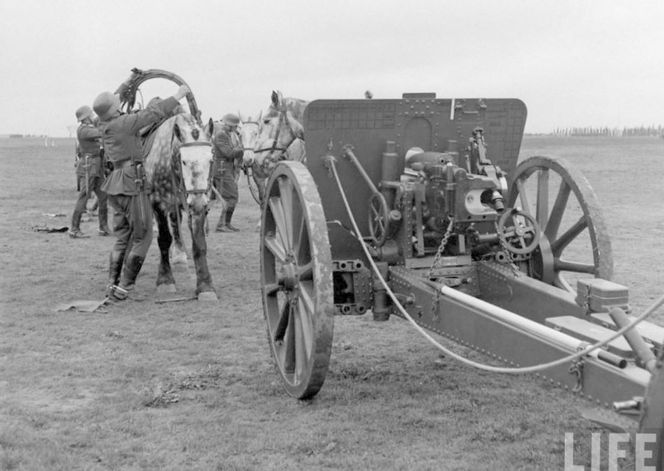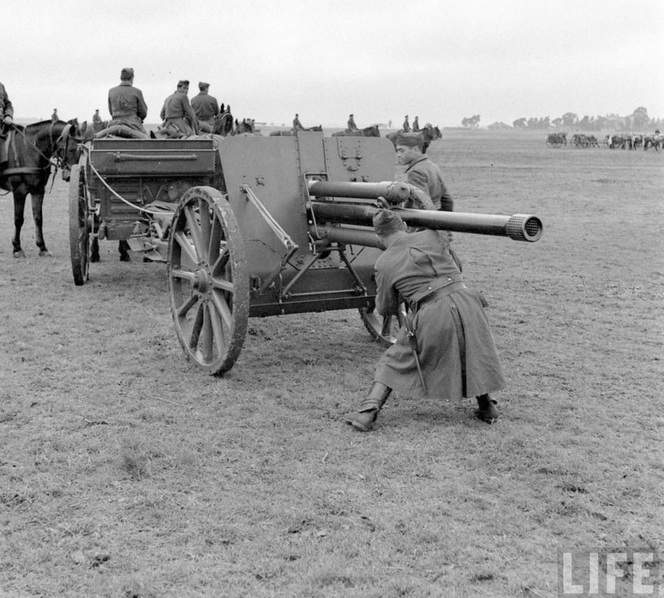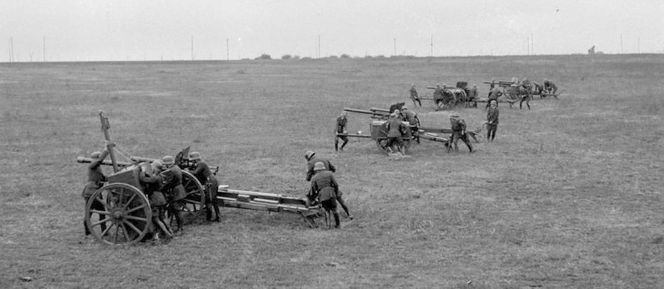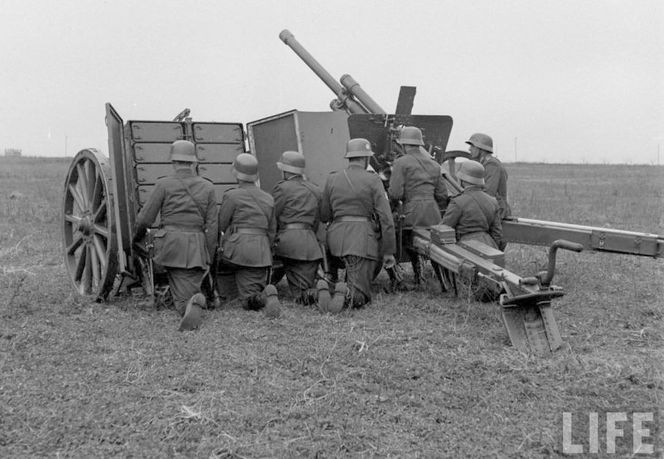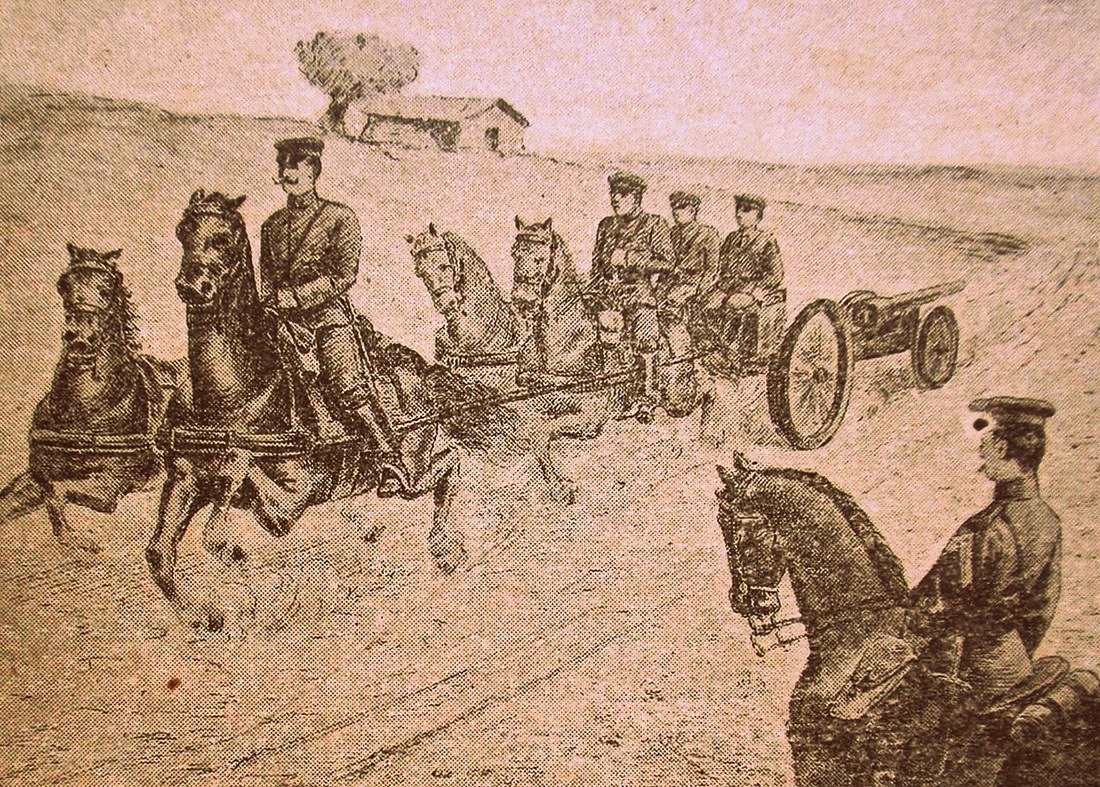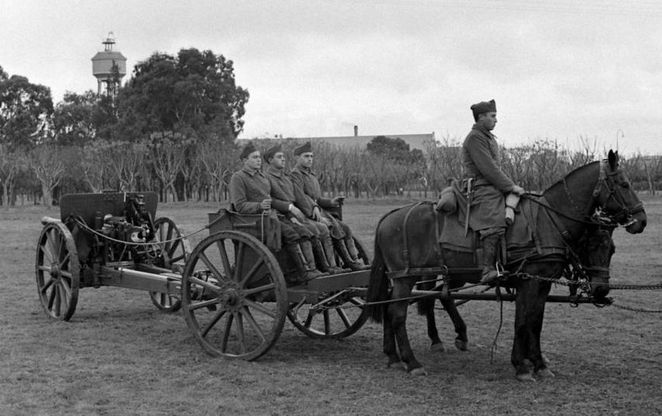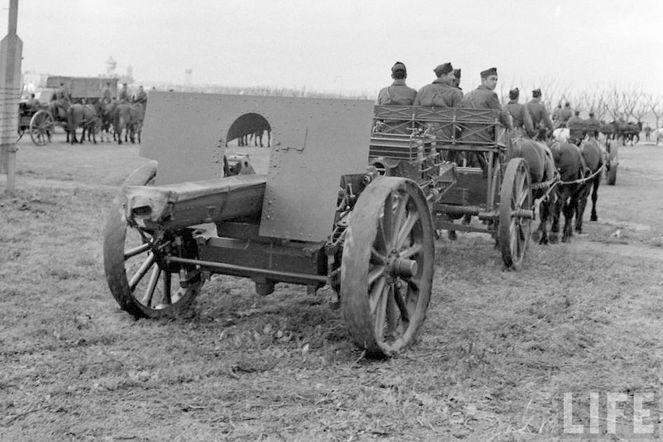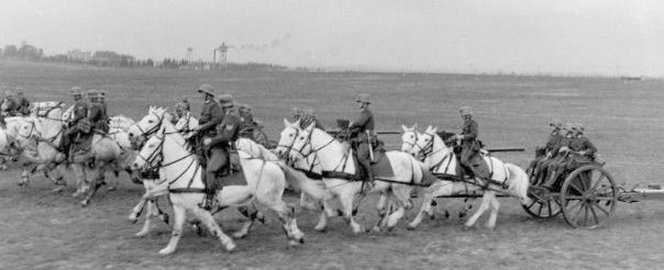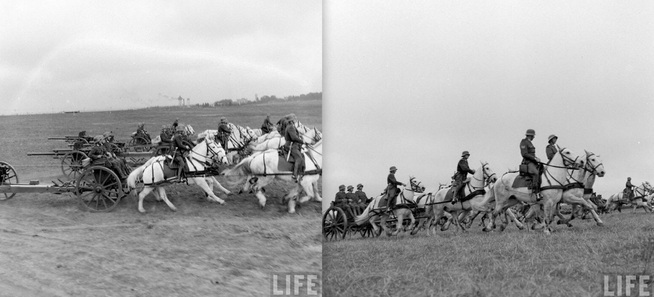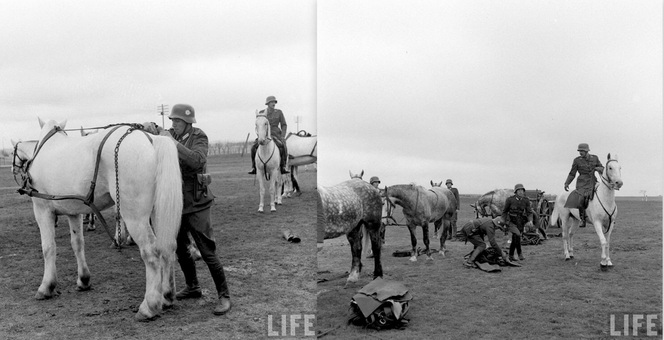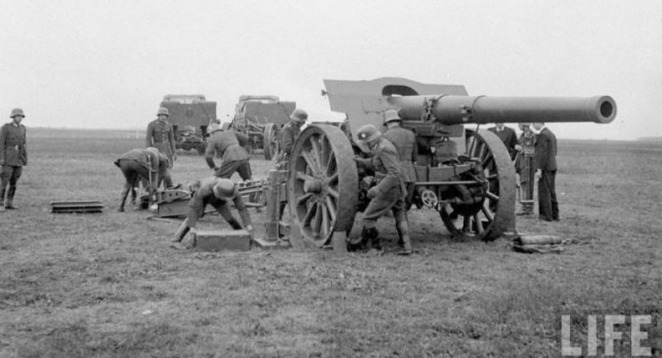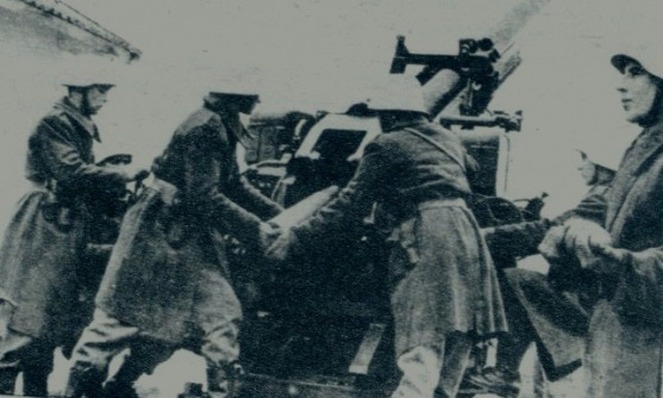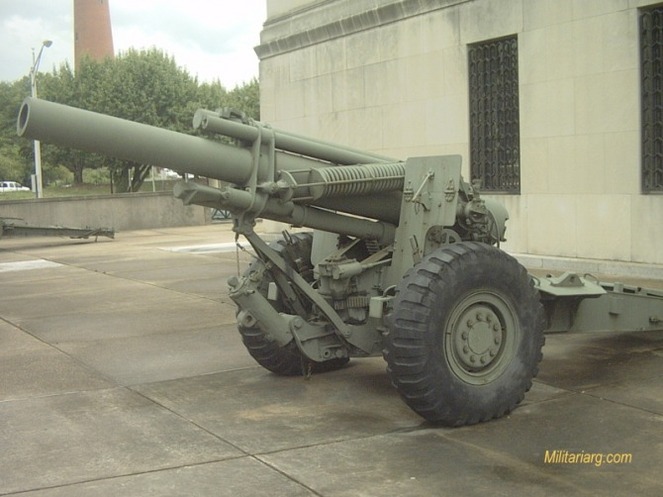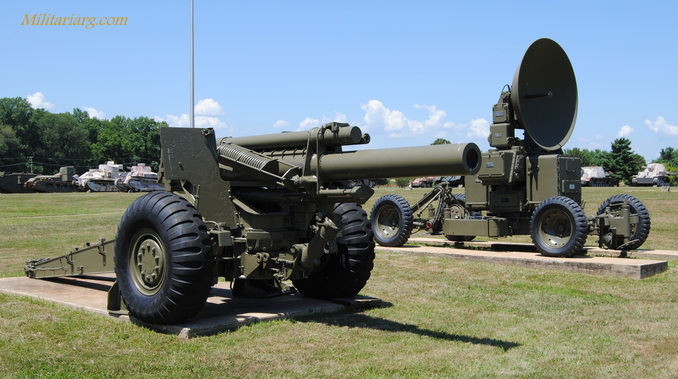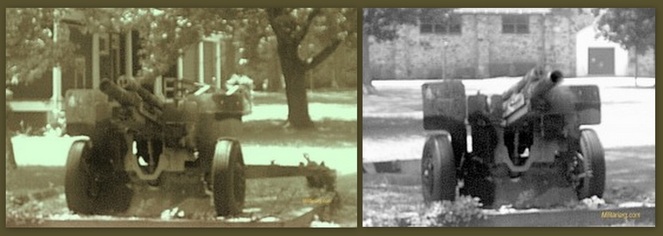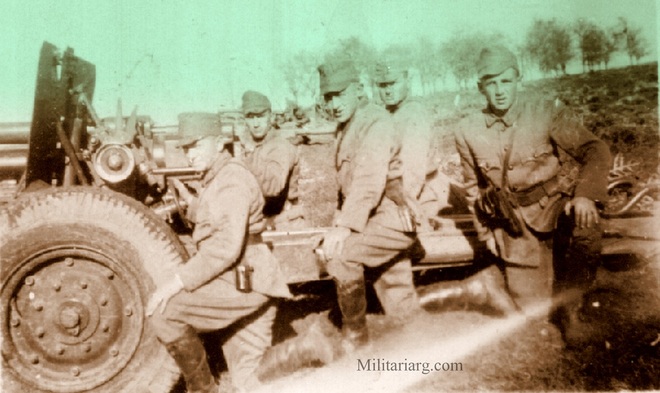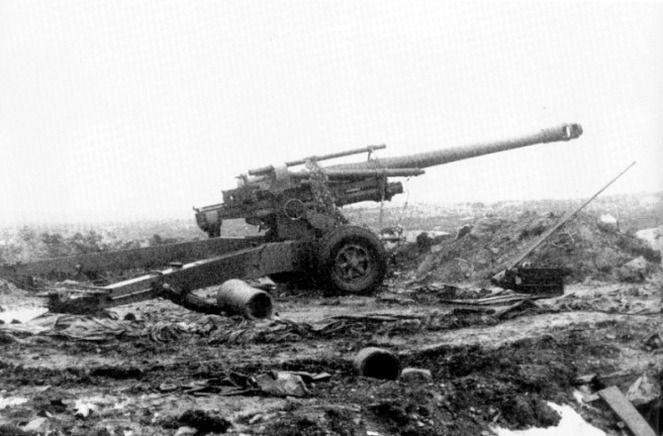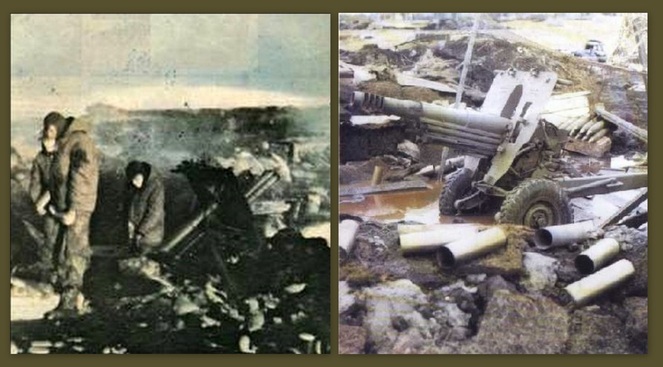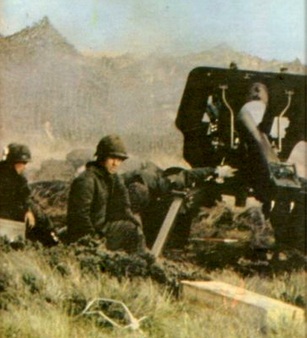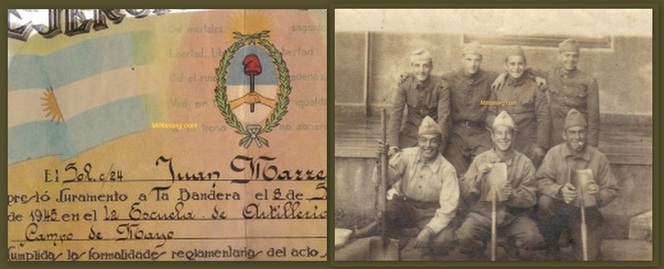Studio photo of artillery soldier w/shrapnel projectile.
Schneider and Krupp grenades:
Argentina, Chile and Bulgaria adopted the Krupp universal shell. Also Germany and Austria-Hungary for their field gun and field howitzers introduced the Krupp and Ehrhardt universal shells with only some insignificant changes. The Schneider universal shells on the contrary were not greatly appreciated.
Read more: Universal shells for quick-firing 75mm field guns:
http://www.bulgarianartillery.it/Bulgarian%20Artillery%201/Equipment/Universal%20shell_field%20guns.htm
Read more: Universal shells for quick-firing 75mm field guns:
http://www.bulgarianartillery.it/Bulgarian%20Artillery%201/Equipment/Universal%20shell_field%20guns.htm
Field and Heavy Artillery
The Franco-Prussin War was truly a turning point in modern warfare. With newly perfected arms used by the infantry and the artillery, the cavalry charges began their decline. This was evident in the battle at Sadowa where the precision Prussian Dreyse rifles and grooved cannons defeated the Austrian troops.
Despite the superiority of the French Chassepot rifles and the increasingly visible fire power of the artillery and infantry, the appearance of polygonal rifling, smokeless powder, precision rifles, Gaitling machine guns was ignored by the French high command. They preferred to send their cuirassiers to their romantic death on horseback, dressed in armor and helmets without firearms into the curtain of smoke on the battlefields of Rezonville and Morsbronn where a great portion of the French cavalry was massacred. On some opportunities Prussian officers ordered a ceasefire due to their admiration for the French riders' sacrifice of launching themselves into certain death. The Prussians even offered military honors to them.
These experiences were undoubtedly kept in mind when the Argentine high command had to equip the military with potent firearms from he era and teach the new land doctrines. Schneider (French) and Krupp (German) are the 2 industrial brand protagonists in Argentina's artillery at the end of the XIX and middle of the XX centuries.
Notable Figures
Left: Brigadier Gral Tomas de Iriarte. Center. Cnel Martiniano Chilavert. Right: Gral Domingo Viejobueno.
Brigadier General Tomas de Iriarte was an officer during the war of independence who passed from the Spanish band to the Argentine side. He fought against Brazil and in successive civil wars. Today the Regimiento de Artillería 1 bears his name in remembrance.
Martiniano Chilaver was an artillery hero. In 1852 during the Battle of Monte Caseros, he was in charge of the field artillery among the allied Brazilians, Uruguayans and Argentines. He and his men were the last on the battlefield and continued to resist, changing positions to cover the retreating troops from the Confederacion Argentina. When the defeat was complete, he was left alone with his battery returning fire until the last bullet. He was taken prisoner and executed.
In 1879 General Domigo Viejobueno was named president of the commission that would study the modifications and modernizations that the army should impose. He arranged a deal with Krupp and Maxim smelting.for modernized field battery. Viejobueno constructed the first national bronze striped cannons with a Krupp system who fabrication was designed by him.
Brigadier General Tomas de Iriarte was an officer during the war of independence who passed from the Spanish band to the Argentine side. He fought against Brazil and in successive civil wars. Today the Regimiento de Artillería 1 bears his name in remembrance.
Martiniano Chilaver was an artillery hero. In 1852 during the Battle of Monte Caseros, he was in charge of the field artillery among the allied Brazilians, Uruguayans and Argentines. He and his men were the last on the battlefield and continued to resist, changing positions to cover the retreating troops from the Confederacion Argentina. When the defeat was complete, he was left alone with his battery returning fire until the last bullet. He was taken prisoner and executed.
In 1879 General Domigo Viejobueno was named president of the commission that would study the modifications and modernizations that the army should impose. He arranged a deal with Krupp and Maxim smelting.for modernized field battery. Viejobueno constructed the first national bronze striped cannons with a Krupp system who fabrication was designed by him.
San Martin and Fray Luis Beltran. Fray Luis Beltran was a priest who, curiously, was in charge of the arsenals for the Andean Army during the war for independence. This priest (of French origin?) with knowledge of chemistry and ironwork dedicated himself to making all types of equipment, from cannons (4" Mountain Artillery), rifles, sabres, powder and uniforms.
The 19th century artillery was divided into Siege and campaign. The siege artillery used the most powerful pieces, like the 24-inch. Field Artillery, Mounted or foot,(4, 8 and 12 inches), acting in the open-field, hence the denomination Field Gun. A standard battery from this time consisted of six pieces, which could include one or two mortars.
The maxime range could reach 800-900 meters, with relative efficiency of 400. When close combat was near, Part servers placed a bucket of metal splinters or nails. The rate of fire was slow, taking into account that with every shot they had to brush the cannon. A well-trained crew could make two rounds per minute.
The 19th century artillery was divided into Siege and campaign. The siege artillery used the most powerful pieces, like the 24-inch. Field Artillery, Mounted or foot,(4, 8 and 12 inches), acting in the open-field, hence the denomination Field Gun. A standard battery from this time consisted of six pieces, which could include one or two mortars.
The maxime range could reach 800-900 meters, with relative efficiency of 400. When close combat was near, Part servers placed a bucket of metal splinters or nails. The rate of fire was slow, taking into account that with every shot they had to brush the cannon. A well-trained crew could make two rounds per minute.
Argentine Mountain Artillery January 19 to February 13, 1817.
18th Century. Spanish Siege Mortars. National Historical Museum (Argentina). Caras y Caretas 1938.
Mounted/Light Artillery:
The artillery force that served in the Argentine forces from 1810 until May 9, 1826 had no numbered order. It was in 1826 when the Mounted Artillery Regiment 1 or Light was created and whose first head was Colonel Iriarte. The
regiment began counting on 21 officers, almost all former students of military academies in the Spanish Viceroyalty, 35 NCOs, 9 horns (for the time a weapon of communications), and 230 soldiers. Iriarte and his men were highlighted
during the First War with the Empire of Brazil, with special mention to the officers Chilavert Arengreen and Piran. Then the regiment would pass to the orders of General Juan Ramón Balcarce. A battery assisted Mayor Juan B. Thorne to defend the island Martin Garcia against the French. In this act of war Argentine Corporal Estanislao Maldones drove one of the guns and later managed to be second in command of that regiment.
John Thorne, an Argentine officer, was born in New York and nicknamed "The deaf of Obligado Combat" for a disability suffered after the fight against the Anglo-French forces at the battle of Quebracho and Obligado in 1845.
Later the regiment was employed in all of Parana, where they fought Garibaldi, Prussian forces, and other mercenaries.
During the Battle of Caseros in 1852, the Regiment under Colonel Martiniano Chilavert faced a Brazilian, Uruguayan and Argentine alliance, among whom was Colonel Piran former member of the Regiment. Chilavert Colonel remained
with only 60 guns and 500 wagons after the flight of his troops.
Source: Captain Ricardo Schauman, 1933.
regiment began counting on 21 officers, almost all former students of military academies in the Spanish Viceroyalty, 35 NCOs, 9 horns (for the time a weapon of communications), and 230 soldiers. Iriarte and his men were highlighted
during the First War with the Empire of Brazil, with special mention to the officers Chilavert Arengreen and Piran. Then the regiment would pass to the orders of General Juan Ramón Balcarce. A battery assisted Mayor Juan B. Thorne to defend the island Martin Garcia against the French. In this act of war Argentine Corporal Estanislao Maldones drove one of the guns and later managed to be second in command of that regiment.
John Thorne, an Argentine officer, was born in New York and nicknamed "The deaf of Obligado Combat" for a disability suffered after the fight against the Anglo-French forces at the battle of Quebracho and Obligado in 1845.
Later the regiment was employed in all of Parana, where they fought Garibaldi, Prussian forces, and other mercenaries.
During the Battle of Caseros in 1852, the Regiment under Colonel Martiniano Chilavert faced a Brazilian, Uruguayan and Argentine alliance, among whom was Colonel Piran former member of the Regiment. Chilavert Colonel remained
with only 60 guns and 500 wagons after the flight of his troops.
Source: Captain Ricardo Schauman, 1933.
Valee French system, Artillery train limber and gun. Capture of a daguerrotype.from 1854 in Buenos Aires.
75mm M1881, "Cnl Viejobueno", Krupp System.
This is the first breech loading cannon fabricated in Argentina. Photo: Carlos Turone "2nd Patricios of Obligado Battalion".
Details of the breech mechanism. This is outside of the Museo de Armas de la Nacion. Many thanks to Oscar Turone for sharing these images with us.
Field and Heavy Artillery:
(The following list may be incomplete or erroneous in some data. If you have any information, please write to us.)
With respect to the early XIX Century, we can find old bronze cannons from the colonial, era or the independence era, some of which we see in museums or paintings, probably 2", 4" 6 ", 8", 12" and 18" inches calibers, (12" Field Gun, 18 Fortress Gun and 24" Siege ?), 6" "Grivehowitzers . We will try to add images and simple, basic details of these antique pieces.
1826 a 8 Cannon; 1st Light Artillery Regiment by Enrique Freccia.
Interesting image from the magazine Caras y Caretas from 1935. It shows an example of old cannons from the era of the Argentine Confederation, once used in the independence war and re-furbished around 1860. This cannon in particular is from the 18th Century Royal Spanish Artillery and re-used by Argentina in its war for independence and other successive wars. In the middle of the 19th Century (when they were becoming obsolete), they served the towns to alert residents of Indian attacks. Many remained in the plazas, as each Town had one or more per fort.
During The Artillery Park Revolution or July 1890 Revolution: General Campos ordered the defense of the Park and had Krupp cannons installed at the six intersections that guarded the access points. Major Ricardo Day, with the help of Captains Roldán and Fernández and Lieutenant Layera carried it out. Especially critical would be the series of batteries located on the corner of Talcahuano and Viamonte, at the door of the Escuela Avellaneda, one block away from the Park on the same street. Captains Manuel Roldán and Luis Fernández rebelled with their strategic Regimiento 1º de Artillería, with the news Krupp 75 cannons under the leadership of Major Ricardo Day. Source and Photo: Wikipedia.
Old Artillery Park. This castle was torn down and the site now hosts the Court (Palacio de Justicia).
1890, Artillery Arsenal. Krupp 75mm M1889 Field Gun. Photo: Caras y Caretas.
The Paraguayan government before the War of Paraguay (1864-1870), had ordered pieces from Krupp but never received them. In 1865 Argentina aquired its first Krupp cannon, of 75 mm, a mountain model that was sent to the front immediately
and followed up by 11 more. Possibly the Argentine Artillery from Caseros until the War of Paraguay had an obsolete park in the Muzzleloader type, modernized in 4, 8 and 12 inch caliber (Mountain), 6" Field Howitzer and Siege 8". Possibly a French origin. Recall that the victors in Caseros were armed in Montevideo by France, equipped by Brazil who, in turn, had received arms from England.
and followed up by 11 more. Possibly the Argentine Artillery from Caseros until the War of Paraguay had an obsolete park in the Muzzleloader type, modernized in 4, 8 and 12 inch caliber (Mountain), 6" Field Howitzer and Siege 8". Possibly a French origin. Recall that the victors in Caseros were armed in Montevideo by France, equipped by Brazil who, in turn, had received arms from England.
75mm L25? M1864 Gebirg Kanone (Krupp) ?
65mm L14 M1871 Gebirg Kanone (Krupp) ?
90mm L22 M1873 (Krupp) ?
75mm L? M1875 (Krupp).
80mm L2.28 M1877 (De Bange) ?
75mm L14 M1878 Montagne (Puteaux).
40mm L30 M1880 Gebirg Kanone (krupp).
75mm L11.5 M1880 Gebirg Kanone (krupp).
75mm L27 M1880 (Krupp).
105mm L35 M1880 Fortress Gun (Krupp) ?
75mm L11 M1879-81 (Cnl Viejobueno Krupp System).
75mm L23 M1884 (Krupp).
75mm L24 M1884 (Krupp).
105mm L35 M1884 Fortress Gun (Krupp).
150mm L? M1883 (Krupp) ?
75mm L13 M1885 Gebirg Kanone (Krupp).
105mm L33? M1887 (Krupp) ?
Caras y Caretas 1901.
Krupp 75mm M1884 L/24. Photo: "Soldados 1848 - 1927".
Krupp 75mm M1895 L24. Photo: "Soldados 1848 - 1927".
75mm L24 M1889 Field Gun (Krupp).
105mm L35 M1889 (Krupp).
120mm L11.6 M1891/92 (Krupp) ?
150mm L10.5-8 M1893 (Krupp) ?
75mm L24 M1895 Field Gun (Krupp).
75mm L28 M1895 (Krupp) ?
75mm L13 M1896 (Krupp).
75mm L? M1897 (Puteaux) ?
75mm L23 M1898 (Krupp).
75mm L13 M1898 Gebirg Kanone
(Krupp).
75mm L28 M1898 Heavy Field Gun (Krupp).
105mm L16 M1898 Field Howitzer (Krupp).
75mm L13 M1899 Gebirg Kanone (Krupp).
120mm L11,6 M1901 (Krupp) ?
150mm L18? M1902 (Krupp) ?
75mm L30 M1902 (Krupp).
130mm L26 M1902 Siege cannon (Krupp).
75mm L14 M1904 Gebirg Kanone (Krupp).
105mm L30 M1905 (Krupp) ?
150mm L14 M1905 (Krupp) ?
75mm L28/30 M1905/06 (Krupp).
65mm L17? M1906 Montagne (Schneider-Ducrest) ?
75mm L30 M1906 (Krupp) ?
150mm L14 ? M1906 (Krupp).
75mm L30 M1909 (krupp).
75mm L30? M1910 (Krupp).
150mm L14 M1911 Howitzer (Krupp).
170mm, 250mm minenwerfer, (Mine launchers) ?
According to George Marvin in Universal Military Service in Argentina, there may have been some field pieces from the US. They could have been from the Sarmiento era.
The Artillery in the WWI Era.
The diverse artillery corps with different models and sizes are distributed in Liniers, Campo de Mayo, Diamante, Cordoba and Field General Belgrano in Salta, in addition to two autonomous groups of mountain artillery. 152 officers. 540 NCOs and auxiliaries. 2,470 soldiers. Among some 2,700 horses and mules heads. 112 loads of ammunition. Four spare carriages. eight charges of forging. four loads of sappers. twenty of baggage. twenty-four bastes. This number is for peacetime mobilization should multiply according to circumstances.
Howitzers: Around 1916 the howitzers composed a regiment based in Campo de Mayo. They were divided into three batteries commanded each by a Lieutenant Colonel who was under a Major and three captains at the rate of one battery of four pieces each. Each captain had eight junior officer positions, a surgeon and thirty-nine sNCOs, 270 soldiers, in addition to civilian personnel, veterinarians, pharmacists, administrators, etc. The cavalry consisted of 17 riding horses for officers, 47 for troops, and 185 for loads, 12 ammunition wagons, six of food and one of health. The howitzers were for siege and campaign (field gun). Those for siege at 150mm M1911 had a range of 6,600 meters. Those for campaign at 105mm L16 M1898 also had a range of 3,700 m with average charge and 6,490 m with maximum charge.
Five Regiments of Mounted Artillery and two Groups of Mountain Artillery based in Salta and Mendoza. The Horse Artillery are 75mm L30 M1909 with maximun range of 6,600 mts.
The mountain cannons are 75mm Krupp L13 M1885 with a range of 4000 meters, 1898 models are the same caliber and same maximum range.
The sections of mountain artillery, are led by two lieutenant colonels, two majors and four captains, with fourteen officers. Ninety NCOs and 500 soldiers. Twenty-six riding horses for officers. Three hundred thirty mules. 16 pieces of food with four wagons and six of fodder (animal feed).
Siege and Fortress pieces:
The 1902 models size 13cm L26 have a maximum range of 10,800 meters.
The 105mm M1884 L35 Fortress Gun has 9500 meters of range.
Five Regiments of Mounted Artillery and two Groups of Mountain Artillery based in Salta and Mendoza. The Horse Artillery are 75mm L30 M1909 with maximun range of 6,600 mts.
The mountain cannons are 75mm Krupp L13 M1885 with a range of 4000 meters, 1898 models are the same caliber and same maximum range.
The sections of mountain artillery, are led by two lieutenant colonels, two majors and four captains, with fourteen officers. Ninety NCOs and 500 soldiers. Twenty-six riding horses for officers. Three hundred thirty mules. 16 pieces of food with four wagons and six of fodder (animal feed).
Siege and Fortress pieces:
The 1902 models size 13cm L26 have a maximum range of 10,800 meters.
The 105mm M1884 L35 Fortress Gun has 9500 meters of range.
130mm L26 M1902 (Krupp). Phot: Caras y Caretas.
130mm Krupp, L26 M1902 siege cannon. Photo from the book "Universal Military Service in Argentina" by George Marvin
Krupp 105mm built-up barrel, Fortress Gun.
The command of the mounted artillery are headed by five lieutenant colonels, 15 majors and 20 captains, with 65 junior officers, 95 assistants and 300 workers and 1700 NCOs places soldiers.
One hundred twenty five riding horses for officer. three hundred ten for Troops. two hundred twenty-five carriage horses.
The total of artillery and wagons eaches eighty pieces, with the same number of wagons and ammunition. Complemented by twenty wagons of observation. twenty of battery. twenty of forge, twenty-five with equipment. The food for these forces are transported in twenty wagons. The food for the animals in twenty wagons. The Medic Corps has five ambulance-wagons. Variable number of ammunition-wagons.
Source: Caras y Caretas Magazine, 1916.
One hundred twenty five riding horses for officer. three hundred ten for Troops. two hundred twenty-five carriage horses.
The total of artillery and wagons eaches eighty pieces, with the same number of wagons and ammunition. Complemented by twenty wagons of observation. twenty of battery. twenty of forge, twenty-five with equipment. The food for these forces are transported in twenty wagons. The food for the animals in twenty wagons. The Medic Corps has five ambulance-wagons. Variable number of ammunition-wagons.
Source: Caras y Caretas Magazine, 1916.
Krupp 75mm. Photo from the book "Universal Military Service in Argentina" by George Marvin
Krupp 75mm M1909. Photo from the book "Universal Military Service in Argentina" by George Marvin
75mm L30 M1909 Krupp.
Krupp 75mm M1909 L/30.
105mm L35 M1898 Krupp Circa 1916. 1st Howitzer Regiment from Campo de Mayo.
105mm M1898.These models were made in Europe under the supervision of Argentine technicians. Many models came customized by the request of the Commission which explains some differences between European and Argentine versions.
105mm L16 M1898. Caras y Caretas 1916.
On the left is Major Adolfo Baisi who designed the slide rule for the Krupp 1909. Curiously, Adolfo Baisi was the father of Alfredo Baisi, designer of the DL43 tank, a machine that utilized a Krupp 1909 cannon as its principal arms. The Major on the right is Francisco Velez who developped or improved the systems for range and accuracy in rapid fire cannons. Source: Caras y Caretas 1913.
WWII Era:
105mm L12,4 M1928 Howitzer Montagne/Field Gun (Schneider).
105mm L17.8 M1928 Field Gun (Schneider).
105mm L18.6 M1928 Howitzer (Schneider).
105mm L30 M1928 (Schneider).
155mm L15 M1928 Howitzer (Schneider).
75mm L12,4 M1928 Montagne (Shneider).
75mm L18 M1928 Montagne (Schneider).
220mm L10,8 Mortar (Schneider)
155mm L30,8 M1928 (Schneider).
75mm L40 M1935 (Bofors).
According to Bernhard Menne in his "Blood And Steel The Rise Of The House Of Krupp (1938)", Publisher: Lee Furman, Inc New York, The Argentine Artillery (Before WWI), was complete re-equipment with sixty batteries of modern
quickfiring guns pre-selected from several competitors: Armstrong, Vickers, Schneider, Ehrhardt and Krupp.
"Schneider vainly complained that Krupp was in the privileged position of being the only firm to give the Argentine gun crews preliminary instruction; that in the event of one of their guns bursting they were not, contrary to the
usual practice, automatically disqualified, but permitted to exchange the damaged gun and were not called upon to submit to a breaking test. Schneider complained also that one of Krupp's fitters had been caught red-handed, tampering with the brake mechanism of a gun which had been officially sealed by the Argentine officers". All the same, the artillery soldiers of South America considered Krupp to be the best from 1865 until WWI. The Paraguayan government before the War of Paraguay (1864), had ordered pieces from Krupp but never received them. In 1865 Argentina aquired its first Krupp cannon.
Towards the end of the XIX century and beginning of the XX century, Argentina and Chile had Krupp as their principal provider, while Peru was a monopoly almost exclusive to the French firm Schneider.
This arms competition ended with the Treaty of Versalles. In the Argentine case, it was the end of Krupp hegemony and the beginning of the Schneider in the post-WWI era. Argentina at the beginning of WWI no longer received arms of German origin until the arrival of FLAK 88 Krupp AA during WWII, but these did not arrive directly by contracts with Berlin but rather as surplus from the Spanish Civil War via Spain or Portugal. In the post-WWII era, the surplus artillery began to arrive from the allies, especially the USA and UK.
quickfiring guns pre-selected from several competitors: Armstrong, Vickers, Schneider, Ehrhardt and Krupp.
"Schneider vainly complained that Krupp was in the privileged position of being the only firm to give the Argentine gun crews preliminary instruction; that in the event of one of their guns bursting they were not, contrary to the
usual practice, automatically disqualified, but permitted to exchange the damaged gun and were not called upon to submit to a breaking test. Schneider complained also that one of Krupp's fitters had been caught red-handed, tampering with the brake mechanism of a gun which had been officially sealed by the Argentine officers". All the same, the artillery soldiers of South America considered Krupp to be the best from 1865 until WWI. The Paraguayan government before the War of Paraguay (1864), had ordered pieces from Krupp but never received them. In 1865 Argentina aquired its first Krupp cannon.
Towards the end of the XIX century and beginning of the XX century, Argentina and Chile had Krupp as their principal provider, while Peru was a monopoly almost exclusive to the French firm Schneider.
This arms competition ended with the Treaty of Versalles. In the Argentine case, it was the end of Krupp hegemony and the beginning of the Schneider in the post-WWI era. Argentina at the beginning of WWI no longer received arms of German origin until the arrival of FLAK 88 Krupp AA during WWII, but these did not arrive directly by contracts with Berlin but rather as surplus from the Spanish Civil War via Spain or Portugal. In the post-WWII era, the surplus artillery began to arrive from the allies, especially the USA and UK.
On the right is a caricature of the president. Many caricatures were done during the 1920s and 1930s, especially of Alvear, Justo and Ortiz. Caras y Caretas 1925.
Krupp 105mm l16 M1998 Howitzer. Note the pedestal sight with a telescope.
130mm 1.3 cm L26 M1902 (Krupp).
Left: 130mm L26 M1902 (Krupp). Right: 76.5mm L50 M1928 AA (Skoda). Photos: Caras y Caretas 1933.
130mm Heavy Artillery, (Krupp).
150mm 15cm L/14 M1911 Modelo Argentino Howitzer (Krupp)
Krupp Ammunition wagon 150mm.
Ammunition avantren.
Krupp obserbatory wagon
Schneider 75mm Mountain or 75mm M1906 Krupp ?
Krupp 75mm M1898 L13 Gebirg Kanone. Caras y Caretas 1932.
75mm L30 M1905/6 Krupp?
Caras y Caretas 1930.
Caras y Caretas 1933.
105mm Schneider
Artillery Major Domingo Mercante.
75mm Model L30,10 Krupp (1909): http://www.cannonsuperstore.com/sold_german.htm
Artillery School, Campo de Mayo (May Field) (1945)
155mm 15.5cm Howitzer Shneider. .
155mm Schneider mod. 1928 L.15
Schneider 1.5cm 155mm howitzer
Soldiers of the Artillery School Sgt. Cabral 1945 (Heavy Artillery).
75mm 7.5cm Cannon. Bofors 75mm M35 L40
Demonstration of shooting mechanics (tiro mecanico) before military attaches. Photo is from 1945 from an artillery school.
Schneider Howitzer 155mm L15 M28.
1st Artillery Regiment of Ciudadela (1945)
Left: Schneider 105mm. Right Scheneider mod. 1928 75mm.
Schneider howitzer 15cm 155mm L.15 mod. 1928 and mod. 1929.
1.5 ton Chevy trucks and trailers with Schneider 105mm. Thornicroft truck w/schneiders 155mm L.31.
Schneider howitzer 15cm 155mm L.15 mod. 1928 and Chevys mod. 41/42 w/oerlikon 20mm AA.
Schneider 155mm.
Artillery School, Campo de Mayo (May Field) 1948
CCKW-352 (SWB) Short wheelbase, prime mover for the field artillery (155mm). The trucks were very similar to the CCW but without front wheel drive.
Schneider 155mm howitzer.
105mm L17.8 M1928 Schneider Field Gun.
Photos from "Caras y Caretas".
Photos from the archives of LIFE magazine
Field Artillery Gunnery Tables. Artillery Board.
Topographic maps and survey to artilery
Artillery Board, (Tablero de Poligonales) .Revista del Suboficial 1944 (NCO, Magazine).
Bofors 7.5cm 75mm L.40 mod. 1935.
Horse Artillery and crew
Bofors 75mm gun
155mm Schneider cannon transport wagon.
Schneider 155mm L30 M1929.
Above photo found on Wikipedia showing a crew loading a cannon. The cannon is a US made 90mm m1a1, a powerful antiair weapon that can be used as antitank under certain cicumstances.
155mm M114a1, (M1A2). Medium Field Howitzer.
M114A2. Aberdeen Museum. Carriage-Howitzer M1A2. The Oliver Corp 1955.
The 155mm M114A1 were an Argentine attempt to replace the older Schneider 155mm. The 155mm were later replaced by the 15mm L33 Citer M77/81 (developed in the 1970s). This gun was based on the French Mk F3 155mm self-propelled gun (also in service in Argentina). In the 1980s CITEFA developed the 155mm L45 CALA 30/2 Gun to replace the CITER-SOFMA 155mm. Info found on Wikipedia.
105 mm M2A1 (M101A1) Light Field howitzer.
Modernized & Upgraded pieces
75mm
Malvinas Campaign
CITER 155mm L33 Field Gun. Latinoamericastudies.
105mm L14 M56 Pak Howitzer Oto Melara.
Desperate combat until the last of the cartridges which could not be replenished due to the blockade. The enemy continues to overpower the terrain. "La Semana" Magazine 1982.
This page is dedicated to Artillery Conscript Soldier Sol. C/24, Juan Carlos Mazzeo
